DAMMING TIBET’S RIVERS
NEW THREATS TO TIBETAN AREA UNDER UNESCO PROTECTION
DAMMING TIBET’S RIVERS
NEW THREATS TO TIBETAN AREA UNDER UNESCO PROTECTION
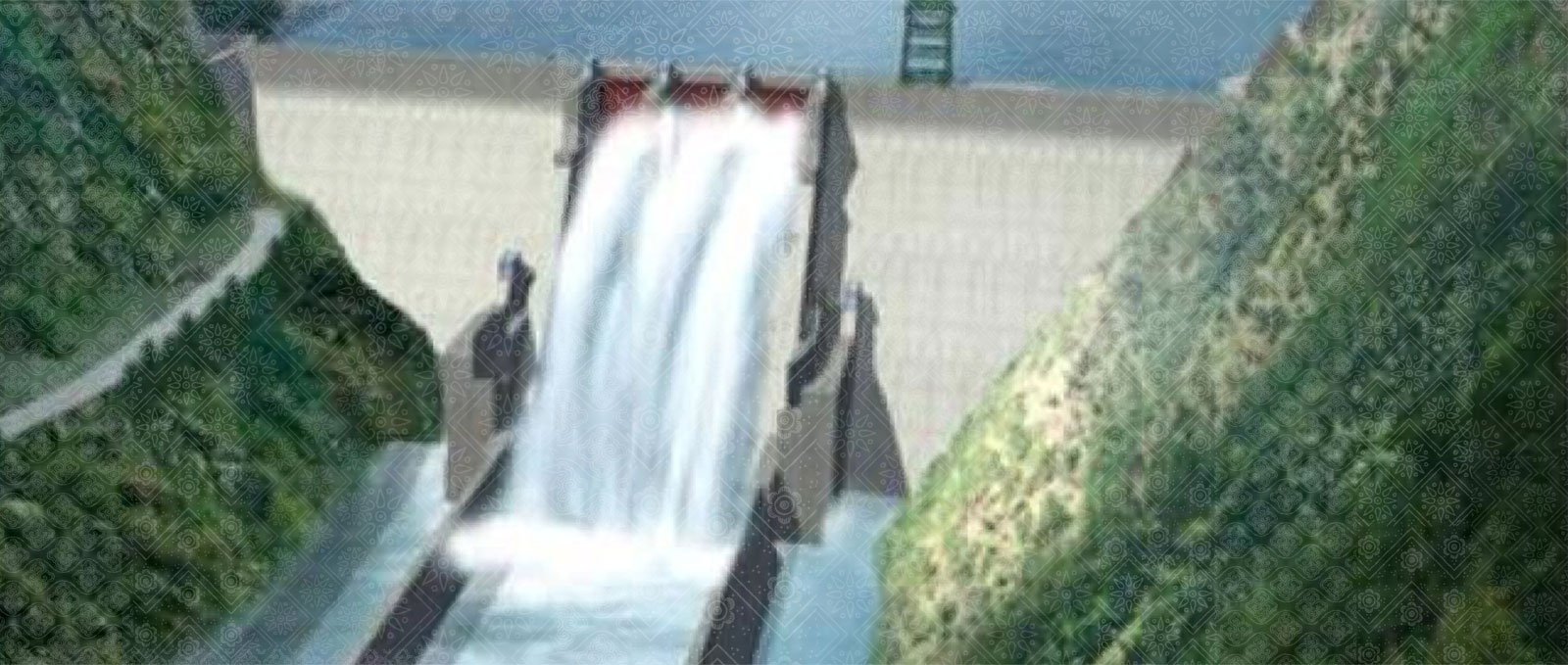
- The Chinese government plans to construct large hydropower stations in Tibetan areas, likely to have a negative impact on the environment and to lead to the relocation of thousands of local people. At least one project directly affects a UNESCO protected World Heritage site.
- An official report from early 2019 and published by Chinese government ministries, refers to specific hydropower dams that are planned, including the Longpan 6000-megawatt dam across the Tiger Leaping Gorge, directly adjacent to the UNESCO protected Tibetan area and World Heritage site of “Three Parallel Rivers” in Yunnan province.
- This dam was previously stalled following campaigns by Chinese environmentalists and warnings of potential massive landslides. Although the Chinese government report to UNESCO on the “Three Parallel Rivers” (November 2018) implies the construction of the Longpan dam is far from imminent, local sources have expressed concerns that construction of the Longpan dam across the Tiger Leaping Gorge will start this year. The dam poses an unprecedented danger to this vitally biodiverse area and will most likely lead to the relocation of local people.
- The Longpan dam is part of a cascade of eight dams along the middle reaches of the Drichu (Ch: Jinsha) river. It will be part of the at least 27 hydropower stations planned on the river that forms the headwater the Yangtze River (Ch: Changjiang). Hydropower projects in the upper reaches of the Drichu – government documents suggest 13 are on the plan – may have already had a negative impact on the UNESCO World Heritage site of “Three Parallel Rivers.” Their impact will significantly increase as dams are gradually completed. However, being geographically distant to the heritage site, they are excluded from UNESCO scrutiny.
- Images of the locations on the Drichu river reveal the extent of road and infrastructure construction required to transport heavy equipment into the sites, demonstrating that the damage done by dams is not limited to the rivers, and also affects the entire landscape. Until now, these areas were among the least disturbed habitats on earth.
- The official report from 2019 also included dams across Tibet, along the Yarlung Tsangpo (Eng: Brahmaputra, Ch: Yalu Zangbu jiang), the Machu (Eng: Yellow River, Ch: Huanghe) and the Gyalmo Ngulchu (Eng: Salween, Ch: Nujiang) rivers. They are either under construction or in planning, along with a rail and road expressway. The dams represent a serious threat to the Tibetan environment as the Chinese government continues to implement policies that are re-shaping its landscape, displacing Tibetans from their land and imperilling the fragile ecosystem of the world’s highest and largest plateau.
- Despite the risks posed by these dams, China may have succeeded in preventing potential criticism through its ‘elite capture’ of global institutions. For example, China’s powerful power grid and dam industry, headed by senior Chinese Communist Party (CCP) officials, was a sponsor of the UNESCO International Water Conference in Paris on May 13-14, 2019.
- The Chinese government plans to construct large hydropower stations in Tibetan areas, likely to have a negative impact on the environment and to lead to the relocation of thousands of local people. At least one project directly affects a UNESCO protected World Heritage site.
- An official report from early 2019 and published by Chinese government ministries, refers to specific hydropower dams that are planned, including the Longpan 6000-megawatt dam across the Tiger Leaping Gorge, directly adjacent to the UNESCO protected Tibetan area and World Heritage site of “Three Parallel Rivers” in Yunnan province.
- This dam was previously stalled following campaigns by Chinese environmentalists and warnings of potential massive landslides. Although the Chinese government report to UNESCO on the “Three Parallel Rivers” (November 2018) implies the construction of the Longpan dam is far from imminent, local sources have expressed concerns that construction of the Longpan dam across the Tiger Leaping Gorge will start this year. The dam poses an unprecedented danger to this vitally biodiverse area and will most likely lead to the relocation of local people.
- The Longpan dam is part of a cascade of eight dams along the middle reaches of the Drichu (Ch: Jinsha) river. It will be part of the at least 27 hydropower stations planned on the river that forms the headwater the Yangtze River (Ch: Changjiang). Hydropower projects in the upper reaches of the Drichu – government documents suggest 13 are on the plan – may have already had a negative impact on the UNESCO World Heritage site of “Three Parallel Rivers.” Their impact will significantly increase as dams are gradually completed. However, being geographically distant to the heritage site, they are excluded from UNESCO scrutiny.
- Images of the locations on the Drichu river reveal the extent of road and infrastructure construction required to transport heavy equipment into the sites, demonstrating that the damage done by dams is not limited to the rivers, and also affects the entire landscape. Until now, these areas were among the least disturbed habitats on earth.
- The official report from 2019 also included dams across Tibet, along the Yarlung Tsangpo (Eng: Brahmaputra, Ch: Yalu Zangbu jiang), the Machu (Eng: Yellow River, Ch: Huanghe) and the Gyalmo Ngulchu (Eng: Salween, Ch: Nujiang) rivers. They are either under construction or in planning, along with a rail and road expressway. The dams represent a serious threat to the Tibetan environment as the Chinese government continues to implement policies that are re-shaping its landscape, displacing Tibetans from their land and imperilling the fragile ecosystem of the world’s highest and largest plateau.
- Despite the risks posed by these dams, China may have succeeded in preventing potential criticism through its ‘elite capture’ of global institutions. For example, China’s powerful power grid and dam industry, headed by senior Chinese Communist Party (CCP) officials, was a sponsor of the UNESCO International Water Conference in Paris on May 13-14, 2019.
CARVING UP THE TIBETAN LANDSCAPE: DOCUMENTING DAMS THAT IMPACT UNESCO WORLD HERITAGE SITE
This new report by ICT reveals details of dams and infrastructure that are prioritized for construction in Tibet and directly threaten the UNESCO World Heritage-protected area known as the Three Parallel Rivers, which is among the most biologically diverse temperate regions on earth.
Since the ‘Three Parallel Rivers of Yunnan Protected Areas’ property was recognized as a UNESCO World Heritage site in 2003, the Chinese government’s ambitions to exploit its natural resources have expanded dramatically in scope. This is linked to Chinese President Xi Jinping’s global plan to connect economic corridors under the Belt and Road Initiative (BRI).
Now this area on the world’s highest and largest plateau is facing an unprecedented threat from major damming and hydropower projects—the effects of which are likely to be irreversible—as well as copper and molybdenum mining, major infrastructure developments and mass tourism.
In a connected development, the recent completion of the world’s highest altitude high-voltage power grid[1], linked to the construction of a fully electrified high speed rail line from Chengdu in China’s Sichuan Province to Lhasa, demonstrates the CCP’s demand for hydropower based – energy resources and plans to intensify infrastructure construction in Tibet.
These developments are dramatically re-shaping and threatening the Tibetan plateau, which is an epicenter of global climate change. The damming of the rivers on the high plateau is integral to China’s strategic and economic imperatives in Tibet, which involve securing control over borders; expanding mining of the plateau’s rich resources (including uranium, lithium and gold) in order to fuel China’s economic growth; and addressing the growing scarcity of water resources in North and Northeast China with water sourced in Tibet.
CARVING UP THE TIBETAN LANDSCAPE: DOCUMENTING DAMS THAT IMPACT UNESCO WORLD HERITAGE SITE
This new report by ICT reveals details of dams and infrastructure that are prioritized for construction in Tibet and directly threaten the UNESCO World Heritage-protected area known as the Three Parallel Rivers, which is among the most biologically diverse temperate regions on earth.
Since the ‘Three Parallel Rivers of Yunnan Protected Areas’ property was recognized as a UNESCO World Heritage site in 2003, the Chinese government’s ambitions to exploit its natural resources have expanded dramatically in scope. This is linked to Chinese President Xi Jinping’s global plan to connect economic corridors under the Belt and Road Initiative (BRI).
Now this area on the world’s highest and largest plateau is facing an unprecedented threat from major damming and hydropower projects—the effects of which are likely to be irreversible—as well as copper and molybdenum mining, major infrastructure developments and mass tourism.
In a connected development, the recent completion of the world’s highest altitude high-voltage power grid[1], linked to the construction of a fully electrified high speed rail line from Chengdu in China’s Sichuan Province to Lhasa, demonstrates the CCP’s demand for hydropower based – energy resources and plans to intensify infrastructure construction in Tibet.
These developments are dramatically re-shaping and threatening the Tibetan plateau, which is an epicenter of global climate change. The damming of the rivers on the high plateau is integral to China’s strategic and economic imperatives in Tibet, which involve securing control over borders; expanding mining of the plateau’s rich resources (including uranium, lithium and gold) in order to fuel China’s economic growth; and addressing the growing scarcity of water resources in North and Northeast China with water sourced in Tibet.
UNESCO AND HYDROPOWER DEVELOPMENT IN TIBET
UNESCO’s ability to confront development close to the protected Three Parallel Rivers area was compromised by Global Energy Interconnection Development’s sponsorship of UNESCO’s International Water Conference in Paris on May 13-14. GEIDCO, based in Beijing, is led by its Chairman Liu Zhenya,[2] former president of the State Grid Corporation of China and alternate member of the 17th CPC Central Committee.[3] In addition, former Chinese Ambassador to Belgium Xing Qu was appointed deputy director-general of UNESCO in March 2018. This combination of factors casts doubt on the impartiality and independence of the water conference and potentially harms UNESCO’s credibility.
The World Hydropower Congress, held in Paris immediately after the UNESCO conference, was organized by the International Hydropower Association (IHA) with a mission statement of “Delivering on the Paris Agreement and Sustainable Development Goals.” Yet Executive Vice President of the Association Liu Chuxue is also vice president of China’s Three Gorges Corporation, the world’s largest hydropower project and most notorious dam, which displaced more than 1.2 million people and set records for the number of cities and towns flooded, corruption, human rights violations and environmental degradation.[4]
The Rivers Without Boundaries international coalition of civil society organizations, including ICT, states in a message to the World Hydropower Congress that it is engaging in “flagrant deception” with its “attempt to portray large hydroelectric dams as a ‘clean and green’ source of energy,” a portrayal that “conveniently ignores a long legacy of social and environmental catastrophes, economic waste and, all too often, massive corruption schemes that are the antithesis of truly sustainable development.” The joint statement calls upon energy companies and governments to “halt all efforts to dam the world’s remaining free-flowing rivers and concentrate instead on (i) improving efficiency and the sustainability of existing hydropower projects and cascades; and (ii) investing in energy efficiency and truly sustainable renewables.”[5]
As a storehouse of freshwater and the source of Earth’s eight largest river systems, the Tibetan Plateau is a critical resource for the world’s 10 most densely populated nations surrounding it. A major goal of China’s Five-Year Plan of 2016 to 2020 has been to intensify the buildup of dams on all of Tibet’s major rivers, with cascading dams on the wild mountain rivers impacting the Three Parallel Rivers area, all involving powerful state-owned Chinese consortiums, many of which are detailed in this report.[6]
UNESCO AND HYDROPOWER DEVELOPMENT IN TIBET
UNESCO’s ability to confront development close to the protected Three Parallel Rivers area was compromised by Global Energy Interconnection Development’s sponsorship of UNESCO’s International Water Conference in Paris on May 13-14. GEIDCO, based in Beijing, is led by its Chairman Liu Zhenya,[2] former president of the State Grid Corporation of China and alternate member of the 17th CPC Central Committee.[3] In addition, former Chinese Ambassador to Belgium Xing Qu was appointed deputy director-general of UNESCO in March 2018. This combination of factors casts doubt on the impartiality and independence of the water conference and potentially harms UNESCO’s credibility.
The World Hydropower Congress, held in Paris immediately after the UNESCO conference, was organized by the International Hydropower Association (IHA) with a mission statement of “Delivering on the Paris Agreement and Sustainable Development Goals.” Yet Executive Vice President of the Association Liu Chuxue is also vice president of China’s Three Gorges Corporation, the world’s largest hydropower project and most notorious dam, which displaced more than 1.2 million people and set records for the number of cities and towns flooded, corruption, human rights violations and environmental degradation.[4]
The Rivers Without Boundaries international coalition of civil society organizations, including ICT, states in a message to the World Hydropower Congress that it is engaging in “flagrant deception” with its “attempt to portray large hydroelectric dams as a ‘clean and green’ source of energy,” a portrayal that “conveniently ignores a long legacy of social and environmental catastrophes, economic waste and, all too often, massive corruption schemes that are the antithesis of truly sustainable development.” The joint statement calls upon energy companies and governments to “halt all efforts to dam the world’s remaining free-flowing rivers and concentrate instead on (i) improving efficiency and the sustainability of existing hydropower projects and cascades; and (ii) investing in energy efficiency and truly sustainable renewables.”[5]
As a storehouse of freshwater and the source of Earth’s eight largest river systems, the Tibetan Plateau is a critical resource for the world’s 10 most densely populated nations surrounding it. A major goal of China’s Five-Year Plan of 2016 to 2020 has been to intensify the buildup of dams on all of Tibet’s major rivers, with cascading dams on the wild mountain rivers impacting the Three Parallel Rivers area, all involving powerful state-owned Chinese consortiums, many of which are detailed in this report.[6]
UNESCO, THE WORLD’S “GENE BANK,” AND THE DAMMING OF TIBETAN RIVERS
The “Three Parallel Rivers” in the Tibetan area located in Yunnan Province is reputed to be the “gene bank of the world,” with about 7,000 plant species. It is acknowledged by the UNESCO World Heritage Committee as: “A truly unique landscape, which still retains a high degree of natural character despite thousands of years of human habitation. As the last remaining stronghold for an extensive suite of rare and endangered plants and animals, the site is of outstanding universal value.”[7] In this area, the headwaters of the Drichu , Dzachu (Eng: Mekong, Ch: Lancang jiang) and the Gyalmo Ngulchu run side by side in deep canyons, and close to the center is one of the most sacred mountains of Tibet, Khawa Karpo (Ch: Meili Xueshan), an important pilgrimage site associated with Padmasambhava, also known as Guru Rinpoche, an important 8th century Indian master involved with the spread of Buddhism to Tibet. Notably, China’s nomination for UNESCO World Heritage status for the Three Parallel Rivers area actually excluded two of the three great rivers (the upper Drichu/Yangtze and Gyalmo Ngulchu/Salween), and only marginally included a section of the Dzachu/Mekong. This was a strategic choice. By excluding the rivers, the Chinese government retained the authority to approve dam construction by the major state-owned dam-building corporations without impediment. The nominated and UNESCO-approved area therefore constitutes a disconnected jigsaw landscape of deep valleys and mountains, with eight relatively independent geographical areas covering a total area of 1.7 million hectares, including 960,084 hectares of core areas and a buffer zone of 816,413 hectares.[8] In 2010, the Chinese state further disconnected the protected area, by officially modifying the boundaries of the property to allow existing mines in the protected area to continue operations.[9] In approving an intentionally disconnected landscape, UNESCO undermined a foundational principle of biodiversity protection: to protect whole and contiguous landscapes, habitats and ecosystems.[10]
While conceding that it lacks specific jurisdiction, UNESCO has expressed alarm and concern over infrastructure construction strictly “outside the ‘commitment area,’” acknowledging that it has an impact on the heritage property. In 2017, UNESCO stated: “Pressure on the property primarily stems from infrastructure development. Spatially separating conservation and development is not, in and of itself, an effective strategy to ‘harmonize the coexistence and relationship between development and the nature,’ as they put it in one of its fundamental objectives. The highly significant modification of the river systems, which gave the property its name, amounts to a profound landscape change, with additional threats from large-scale water diversion programs. While the projects may be located outside of the ‘commitment area’, the effects of disturbance, loss of connectivity, improved road access facilitating illicit activities and species invasions inevitably accompany large infrastructure projects beyond their spatial footprint. Besides, there are linkages between freshwater biodiversity and processes affected by dams and terrestrial ecosystems. Although located outside the property, the massive hydropower projects and the associated infrastructure objectively change the natural beauty and aesthetic importance of the valleys and their numerous important views, which contribute to the property’s OUV [outstanding universal value] under criterion (vii), and cannot be restricted to selected elements of a landscape. Therefore, the visual impact of these infrastructure projects is considered to exert a direct negative impact on the OUV.”[11]
China’s response to UNESCO in November 2018 claimed: “Two of planned stations, Longpan power station and Liangjiaren power stations, the Ministry of Environmental Protection states, as the aspects of ecological and environmental protection, Longpan power station and Liangjiaren power stations need to be further studied before making any decisions. The relevant construction plans and EIAs have not been completed, reported and ratified. And they are not under construction.”[12]
With regard to the Longpan dam across the Drichu, this assertion is misleading, as according to both Chinese state media sources investigated by ICT and local unofficial sources, construction is considered high priority and is likely to begin later this year. A Chinese media report which was issued a year before China gave its vague update to UNESCO states: “According to the news, the progress of the advancement of the Longpan Hydropower Station, the leading hydropower station of the cascade hydropower station in the middle reaches of the Jinsha River, is expected to accelerate. A press release of Huadian Group’s Yunnan company on August 1 [2017] showed that ‘to do a good job in the preliminary selection of the dam site of the Longtou Reservoir and the preliminary work of the Longpan Power Station, and to complete the pre-feasibility study report for the selected dam site during the year, and to start the feasibility study work in full. Refining the preliminary work and policies to get the job, according to the arrangement of the provincial party committee and the provincial government, we will strive to start construction in 2019.’”[13]
It is not clear why China’s statement to UNESCO gives only a partial list of hydropower projects in the region. The statement says “One hydropower development project, so called one reservoir with eight cascades [sic], along Jinsha River midstream has accomplished constructions of Liyuan, Ahai, Jiananqiao, Longkaikou, Ludila and Guanyinyan power stations.”[14]
Giving much more detail than the statement, the Chinese state media report cited above refers to a total of 27 hydropower stations to be developed or already being developed in the Drichu River basin and other upriver areas. Giving an idea of the size of these projects (although this is likely to be an exaggeration), the Chinese state outlet, Xinhua, states that the combined scale is on the staggering magnitude of about “four Three Gorges projects.”[15]
ICT has studied an authoritative list of large hydropower dams specified in China’s 13th Five Year Plan (2016-2020) published online by China’s National Development and Reform Commission and issued by multiple Chinese government ministries, including the National Energy Board, Ministry of Ecology and Environment, and Ministry of Natural Resources.[16] The hydropower projects in Tibetan areas on this list have been identified in this report. Chinese sources also confirmed details of relocations and resettlement of thousands of people, notably including the possibility of about 100,000 people linked to the Longpan/Tiger Leaping Gorge dam, and more than 58,000 displaced due to hydropower projects in Qinghai, details of which are provided in this report.[17]
Information about massive landslides connected to the construction of dams is also detailed in this report. It has been documented that damming upriver in Tibet carries great risks, particularly as the gorges of these three rivers are still young and seismically active—but the risks are being ignored by the Chinese government.[18] For instance, in October and November 2018, Polo (Boluo) Township in Kardze (Ganzi) was hit by two huge landslides, two years after the authorities had announced the county had been connected to the power grid linked to the construction of a large hydropower station. Polo Hydropower Station on the Drichu River is at the boundary of Jomda (Jiangda) County, Chamdo (Changdu), TAR, and Palyul (Baiyu) County in Kardze, Sichuan Province.[19] The two landslides and subsequent flooding destroyed 100 houses and damaged 1,000 more; Chinese media reported that 6,000 people were evacuated within 24 hours. Tempa Gyaltsen Zamlha, a researcher on Tibet’s environment for the Tibetan Policy Institute of the Central Tibetan Administration based in Dharamshala, believes that the landslides were caused by a number of factors: principally excessive construction work, road-building and possible tunneling in the area.[20] Chinese geologists have warned that the effects of tectonic activity in the Three Rivers region have heightened the occurrence, frequency and impact of natural disasters, such as earthquakes and mudslides.[21]
UNESCO, THE WORLD’S “GENE BANK,” AND THE DAMMING OF TIBETAN RIVERS
The “Three Parallel Rivers” in the Tibetan area located in Yunnan Province is reputed to be the “gene bank of the world,” with about 7,000 plant species. It is acknowledged by the UNESCO World Heritage Committee as: “A truly unique landscape, which still retains a high degree of natural character despite thousands of years of human habitation. As the last remaining stronghold for an extensive suite of rare and endangered plants and animals, the site is of outstanding universal value.”[7] In this area, the headwaters of the Drichu , Dzachu (Eng: Mekong, Ch: Lancang jiang) and the Gyalmo Ngulchu run side by side in deep canyons, and close to the center is one of the most sacred mountains of Tibet, Khawa Karpo (Ch: Meili Xueshan), an important pilgrimage site associated with Padmasambhava, also known as Guru Rinpoche, an important 8th century Indian master involved with the spread of Buddhism to Tibet. Notably, China’s nomination for UNESCO World Heritage status for the Three Parallel Rivers area actually excluded two of the three great rivers (the upper Drichu/Yangtze and Gyalmo Ngulchu/Salween), and only marginally included a section of the Dzachu/Mekong. This was a strategic choice. By excluding the rivers, the Chinese government retained the authority to approve dam construction by the major state-owned dam-building corporations without impediment. The nominated and UNESCO-approved area therefore constitutes a disconnected jigsaw landscape of deep valleys and mountains, with eight relatively independent geographical areas covering a total area of 1.7 million hectares, including 960,084 hectares of core areas and a buffer zone of 816,413 hectares.[8] In 2010, the Chinese state further disconnected the protected area, by officially modifying the boundaries of the property to allow existing mines in the protected area to continue operations.[9] In approving an intentionally disconnected landscape, UNESCO undermined a foundational principle of biodiversity protection: to protect whole and contiguous landscapes, habitats and ecosystems.[10]
While conceding that it lacks specific jurisdiction, UNESCO has expressed alarm and concern over infrastructure construction strictly “outside the ‘commitment area,’” acknowledging that it has an impact on the heritage property. In 2017, UNESCO stated: “Pressure on the property primarily stems from infrastructure development. Spatially separating conservation and development is not, in and of itself, an effective strategy to ‘harmonize the coexistence and relationship between development and the nature,’ as they put it in one of its fundamental objectives. The highly significant modification of the river systems, which gave the property its name, amounts to a profound landscape change, with additional threats from large-scale water diversion programs. While the projects may be located outside of the ‘commitment area’, the effects of disturbance, loss of connectivity, improved road access facilitating illicit activities and species invasions inevitably accompany large infrastructure projects beyond their spatial footprint. Besides, there are linkages between freshwater biodiversity and processes affected by dams and terrestrial ecosystems. Although located outside the property, the massive hydropower projects and the associated infrastructure objectively change the natural beauty and aesthetic importance of the valleys and their numerous important views, which contribute to the property’s OUV [outstanding universal value] under criterion (vii), and cannot be restricted to selected elements of a landscape. Therefore, the visual impact of these infrastructure projects is considered to exert a direct negative impact on the OUV.”[11]
China’s response to UNESCO in November 2018 claimed: “Two of planned stations, Longpan power station and Liangjiaren power stations, the Ministry of Environmental Protection states, as the aspects of ecological and environmental protection, Longpan power station and Liangjiaren power stations need to be further studied before making any decisions. The relevant construction plans and EIAs have not been completed, reported and ratified. And they are not under construction.”[12]
With regard to the Longpan dam across the Drichu, this assertion is misleading, as according to both Chinese state media sources investigated by ICT and local unofficial sources, construction is considered high priority and is likely to begin later this year. A Chinese media report which was issued a year before China gave its vague update to UNESCO states: “According to the news, the progress of the advancement of the Longpan Hydropower Station, the leading hydropower station of the cascade hydropower station in the middle reaches of the Jinsha River, is expected to accelerate. A press release of Huadian Group’s Yunnan company on August 1 [2017] showed that ‘to do a good job in the preliminary selection of the dam site of the Longtou Reservoir and the preliminary work of the Longpan Power Station, and to complete the pre-feasibility study report for the selected dam site during the year, and to start the feasibility study work in full. Refining the preliminary work and policies to get the job, according to the arrangement of the provincial party committee and the provincial government, we will strive to start construction in 2019.’”[13]
It is not clear why China’s statement to UNESCO gives only a partial list of hydropower projects in the region. The statement says “One hydropower development project, so called one reservoir with eight cascades [sic], along Jinsha River midstream has accomplished constructions of Liyuan, Ahai, Jiananqiao, Longkaikou, Ludila and Guanyinyan power stations.”[14]
Giving much more detail than the statement, the Chinese state media report cited above refers to a total of 27 hydropower stations to be developed or already being developed in the Drichu River basin and other upriver areas. Giving an idea of the size of these projects (although this is likely to be an exaggeration), the Chinese state outlet, Xinhua, states that the combined scale is on the staggering magnitude of about “four Three Gorges projects.”[15]
ICT has studied an authoritative list of large hydropower dams specified in China’s 13th Five Year Plan (2016-2020) published online by China’s National Development and Reform Commission and issued by multiple Chinese government ministries, including the National Energy Board, Ministry of Ecology and Environment, and Ministry of Natural Resources.[16] The hydropower projects in Tibetan areas on this list have been identified in this report. Chinese sources also confirmed details of relocations and resettlement of thousands of people, notably including the possibility of about 100,000 people linked to the Longpan/Tiger Leaping Gorge dam, and more than 58,000 displaced due to hydropower projects in Qinghai, details of which are provided in this report.[17]
Information about massive landslides connected to the construction of dams is also detailed in this report. It has been documented that damming upriver in Tibet carries great risks, particularly as the gorges of these three rivers are still young and seismically active—but the risks are being ignored by the Chinese government.[18] For instance, in October and November 2018, Polo (Boluo) Township in Kardze (Ganzi) was hit by two huge landslides, two years after the authorities had announced the county had been connected to the power grid linked to the construction of a large hydropower station. Polo Hydropower Station on the Drichu River is at the boundary of Jomda (Jiangda) County, Chamdo (Changdu), TAR, and Palyul (Baiyu) County in Kardze, Sichuan Province.[19] The two landslides and subsequent flooding destroyed 100 houses and damaged 1,000 more; Chinese media reported that 6,000 people were evacuated within 24 hours. Tempa Gyaltsen Zamlha, a researcher on Tibet’s environment for the Tibetan Policy Institute of the Central Tibetan Administration based in Dharamshala, believes that the landslides were caused by a number of factors: principally excessive construction work, road-building and possible tunneling in the area.[20] Chinese geologists have warned that the effects of tectonic activity in the Three Rivers region have heightened the occurrence, frequency and impact of natural disasters, such as earthquakes and mudslides.[21]
FEARS FOR FUTURE AS TIGER LEAPING GORGE DAM IS PRIORITIZED
FEARS FOR FUTURE AS TIGER LEAPING GORGE DAM IS PRIORITIZED
The list of hydropower dams officially confirms that, contrary to the information given to UNESCO, the Longpan dam across the Tiger Leaping Gorge on the Drichu is going through the official approval process, and according to information received by ICT,[22] there are concerns that construction may begin this year.
A press release of Huadian Group’s Yunnan company on Aug. 1, 2017 showed that “to do a good job in the preliminary selection of the dam site of the Longtou Reservoir and the preliminary work of the Longpan Power Station, and to complete the pre-feasibility study report for the selected dam site during the year, and to start the feasibility study work in full. Refining the preliminary work and policies to get the job, according to the arrangement of the provincial party committee and the provincial government, we will strive to start construction in 2019.”[23]
Introducing a report on the new developments for the International Rivers Network/World Heritage Watch, Gabriel Lafitte writes: “Environmentalists are aghast. So certain these days are arrest, detention, torture and public confession, for publicly questioning official policy, they dare not speak directly. This is their plea.”[24]
Fifteen years ago, in 2004, Chinese environmentalists first learned that a wild mountain river known for the spectacular ‘Tiger Leaping Gorge’ was going to be dammed, together with a planned cascade of dams on the Drichu. The planned dam would be some 200 meters high and would have flooded the Jinsha River valley 200 kilometers upstream and displaced 100,000 people from ethnic minority groups, mostly Tibetans and Naxi people. A reporter from the investigative newspaper Southern Weekend—now closed down (with the link to that story taken offline)[25] broke the news that the dam had begun construction before official permission had been granted. This drew the attention of the then-Premier Wen Jiabao, and the project was later suspended. In a historic campaign in China led by local people, joined by environmentalists and scientists, the state-owned dam company backed down, and construction did not proceed.[26]
The opposition to the Tiger Leaping Gorge dam was a seminal moment for China’s environmental protection movement.[27] But today, 15 years later, the Longpan dam in the Tiger Leaping Gorge, among a number of others detailed in this report by ICT, is back on track.
The list of hydropower dams officially confirms that, contrary to the information given to UNESCO, the Longpan dam across the Tiger Leaping Gorge on the Drichu is going through the official approval process, and according to information received by ICT,[22] there are concerns that construction may begin this year.
A press release of Huadian Group’s Yunnan company on Aug. 1, 2017 showed that “to do a good job in the preliminary selection of the dam site of the Longtou Reservoir and the preliminary work of the Longpan Power Station, and to complete the pre-feasibility study report for the selected dam site during the year, and to start the feasibility study work in full. Refining the preliminary work and policies to get the job, according to the arrangement of the provincial party committee and the provincial government, we will strive to start construction in 2019.”[23]
Introducing a report on the new developments for the International Rivers Network/World Heritage Watch, Gabriel Lafitte writes: “Environmentalists are aghast. So certain these days are arrest, detention, torture and public confession, for publicly questioning official policy, they dare not speak directly. This is their plea.”[24]
Fifteen years ago, in 2004, Chinese environmentalists first learned that a wild mountain river known for the spectacular ‘Tiger Leaping Gorge’ was going to be dammed, together with a planned cascade of dams on the Drichu. The planned dam would be some 200 meters high and would have flooded the Jinsha River valley 200 kilometers upstream and displaced 100,000 people from ethnic minority groups, mostly Tibetans and Naxi people. A reporter from the investigative newspaper Southern Weekend—now closed down (with the link to that story taken offline)[25] broke the news that the dam had begun construction before official permission had been granted. This drew the attention of the then-Premier Wen Jiabao, and the project was later suspended. In a historic campaign in China led by local people, joined by environmentalists and scientists, the state-owned dam company backed down, and construction did not proceed.[26]
The opposition to the Tiger Leaping Gorge dam was a seminal moment for China’s environmental protection movement.[27] But today, 15 years later, the Longpan dam in the Tiger Leaping Gorge, among a number of others detailed in this report by ICT, is back on track.
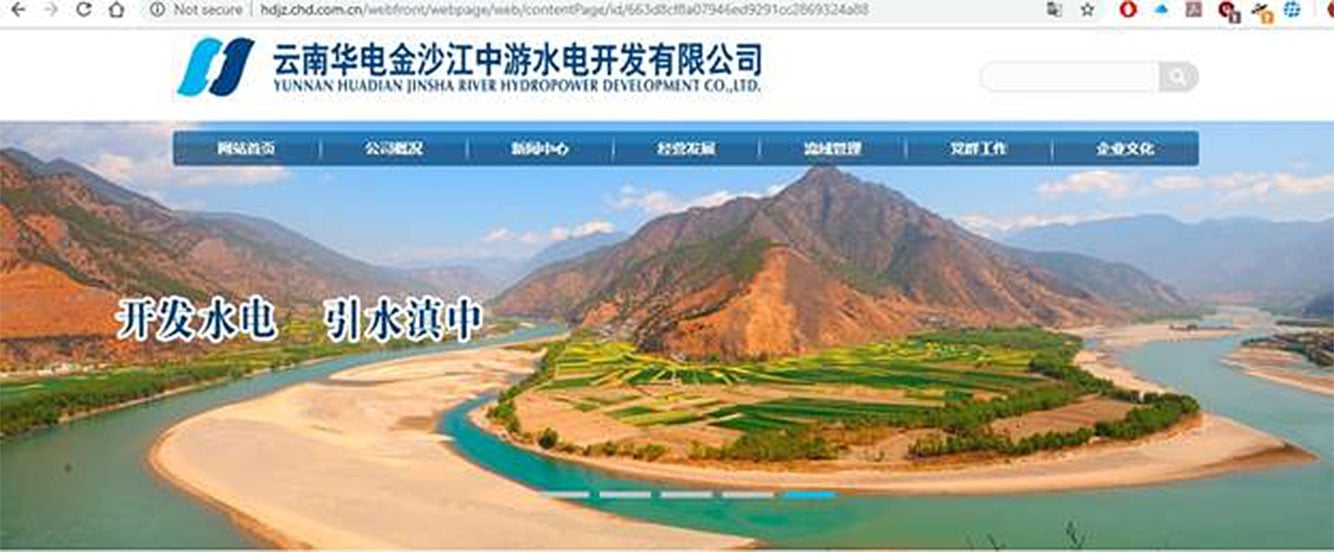
Although Tiger Leaping Gorge is narrow, below it, along the 265 kms of future man-made lake, the river often widens allowing for farmland. This image of the Drichu posted by the dam construction company shows the extent of that farmland and demonstrates the type of landscape that will be flooded for the dam projects. Image from the Yunnan Huadian Jinsha River Hydropower Development Co., Ltd website.

Although Tiger Leaping Gorge is narrow, below it, along the 265 kms of future man-made lake, the river often widens allowing for farmland. This image of the Drichu posted by the dam construction company shows the extent of that farmland and demonstrates the type of landscape that will be flooded for the dam projects. Image from the Yunnan Huadian Jinsha River Hydropower Development Co., Ltd website.
DIZZYING IMPLICATIONS OF THE LONGPAN DAM: LANDSLIDES, EARTHQUAKE FEARS, EXPRESSWAY BRIDGE
DIZZYING IMPLICATIONS OF THE LONGPAN DAM: LANDSLIDES, EARTHQUAKE FEARS, EXPRESSWAY BRIDGE
Tiger Leaping Gorge is a major attraction for tourists, who often experience the wild rushing river by being carried to a glass-bottom viewing platform by sedan chair. The hydropower project stalled at the Gorge 15 years ago has now been renamed, perhaps in order to avoid associations with campaigns against it. The Chinese Baidu (online encyclopedia) reference states: “In order to avoid public doubts, the Tiger Leaping Gorge Hydropower Station was renamed Longpan Hydropower Station.”[28]
Chinese scientists have even wondered whether the right bank of the Drichu river at the site, which is so loose, can hold when the dam is built. The bank is seriously unstable, having been pushed up by the tectonic advance of the Tibetan Plateau, resulting in many fractures. An academic paper by Chinese scientists looks into the likelihood of a massive collapse of the bank, lubricated by the impounding of water behind a dam wall hundreds of meters high.[29]
Scientific research shows that dams of a particular size may be a direct cause of earthquakes via a process known as reservoir-induced seismicity, meaning that the weight of water behind a dam, coupled with the seeping of water into fissures in rocks below, can produce stress strong enough to worsen, or trigger, an earthquake. The most shocking example of this was the 7.9 magnitude Sichuan earthquake in May 2008, which had its epicenter in a Tibetan area and killed more than 87,000 people. Scientists and geologists believe that pressure from the 511-foot high Zipingpu Dam, just 550 yards from the Longmenshan fault line[30] and three miles from the epicenter, may have helped trigger this devastating quake.[31]
The Tibetan plateau is also vulnerable to impacts of an “ecosystem shift” caused by climate change, China’s land use policies and the expansion of infrastructure in Tibet. Scientists have warned that warming temperatures, together with the boom in infrastructure construction and urbanization, are combining to create irreversible damage to the ecosystem, including the predicted disappearance of large areas of grasslands, alpine meadows, wetlands and permafrost on the Tibetan plateau by 2050.[32]
It is not only the implications of a dam in the Tiger Leaping Gorge scenic area that have alarmed environmentalists. In addition, the Chinese response to UNESCO confirms that power transmission lines directly cross the Three Parallel Rivers World Heritage site and were apparently unchallenged by the global heritage body. In response to complaints from UNESCO, the Chinese side asserts simply: “The Government of China hopes, through the EIAs [Environmental Impact Assessment], to minimize the visual impact of transmission lines on the property.”[33]
In its entirety, the Longpan hydropower project involves the simultaneous construction of hydropower dams, aqueducts and tunnels to divert much of the Drichu across Yunnan farmland, concentrated in a small area of deep gorge and mountain river far below the dam wall. Now the Chinese authorities are also promoting two further threats to the UNESCO protected area: two high suspension bridges spanning Tiger Leaping Gorge, one for an expressway road, the other for rail.
The road bridge, promoted in a 26-minute documentary on YouTube, shows the engineering plans for the Lijiang to Gyalthang (branded in English today as Shangri-La, Ch: Xianggelila) expressway across the Jinshajiang bridge, between two snow mountains (the Jade Dragon and Haba), which the authorities boast will be the “largest single tower suspension bridge in the world.” Assigned in the 13th Five Year Plan period, from 2016-2020, the bridge is due to be completed this year. The railway bridge, featured in this video by a Chinese observer, is likely to take longer.
The Chinese response to UNESCO on Longpan also confirms a major water transfer project, the “Dianzhong Water Diversion,” in an area not formally within the borders of the property as defined by UNESCO. The Chinese state party says the planned average water intake to be diverted from the Shigu section in Yunnan of the Drichu is a staggering 34.2 billion cubic meters.[34] Water diversion projects, particularly those on this scale, cause an array of negative impacts such as disruption of rivers’ natural flow, disconnection of a single river ecosystem, changes in habitats of species, and changes in sediment flow and channel processes.[35]
In his report for Rivers Without Borders,[36] Lafitte observes that this flow “will be mostly withdrawn when the river is lowest, in the drier months from September to February. Subtropical lowland Yunnan grows crops year round, if irrigated. This is a threat UNESCO has so far said nothing about.”[37]
Tiger Leaping Gorge is a major attraction for tourists, who often experience the wild rushing river by being carried to a glass-bottom viewing platform by sedan chair. The hydropower project stalled at the Gorge 15 years ago has now been renamed, perhaps in order to avoid associations with campaigns against it. The Chinese Baidu (online encyclopedia) reference states: “In order to avoid public doubts, the Tiger Leaping Gorge Hydropower Station was renamed Longpan Hydropower Station.”[28]
Chinese scientists have even wondered whether the right bank of the Drichu river at the site, which is so loose, can hold when the dam is built. The bank is seriously unstable, having been pushed up by the tectonic advance of the Tibetan Plateau, resulting in many fractures. An academic paper by Chinese scientists looks into the likelihood of a massive collapse of the bank, lubricated by the impounding of water behind a dam wall hundreds of meters high.[29]
Scientific research shows that dams of a particular size may be a direct cause of earthquakes via a process known as reservoir-induced seismicity, meaning that the weight of water behind a dam, coupled with the seeping of water into fissures in rocks below, can produce stress strong enough to worsen, or trigger, an earthquake. The most shocking example of this was the 7.9 magnitude Sichuan earthquake in May 2008, which had its epicenter in a Tibetan area and killed more than 87,000 people. Scientists and geologists believe that pressure from the 511-foot high Zipingpu Dam, just 550 yards from the Longmenshan fault line[30] and three miles from the epicenter, may have helped trigger this devastating quake.[31]
The Tibetan plateau is also vulnerable to impacts of an “ecosystem shift” caused by climate change, China’s land use policies and the expansion of infrastructure in Tibet. Scientists have warned that warming temperatures, together with the boom in infrastructure construction and urbanization, are combining to create irreversible damage to the ecosystem, including the predicted disappearance of large areas of grasslands, alpine meadows, wetlands and permafrost on the Tibetan plateau by 2050.[32]
It is not only the implications of a dam in the Tiger Leaping Gorge scenic area that have alarmed environmentalists. In addition, the Chinese response to UNESCO confirms that power transmission lines directly cross the Three Parallel Rivers World Heritage site and were apparently unchallenged by the global heritage body. In response to complaints from UNESCO, the Chinese side asserts simply: “The Government of China hopes, through the EIAs [Environmental Impact Assessment], to minimize the visual impact of transmission lines on the property.”[33]
In its entirety, the Longpan hydropower project involves the simultaneous construction of hydropower dams, aqueducts and tunnels to divert much of the Drichu across Yunnan farmland, concentrated in a small area of deep gorge and mountain river far below the dam wall. Now the Chinese authorities are also promoting two further threats to the UNESCO protected area: two high suspension bridges spanning Tiger Leaping Gorge, one for an expressway road, the other for rail.
The road bridge, promoted in a 26-minute documentary on YouTube, shows the engineering plans for the Lijiang to Gyalthang (branded in English today as Shangri-La, Ch: Xianggelila) expressway across the Jinshajiang bridge, between two snow mountains (the Jade Dragon and Haba), which the authorities boast will be the “largest single tower suspension bridge in the world.” Assigned in the 13th Five Year Plan period, from 2016-2020, the bridge is due to be completed this year. The railway bridge, featured in this video by a Chinese observer, is likely to take longer.
The Chinese response to UNESCO on Longpan also confirms a major water transfer project, the “Dianzhong Water Diversion,” in an area not formally within the borders of the property as defined by UNESCO. The Chinese state party says the planned average water intake to be diverted from the Shigu section in Yunnan of the Drichu is a staggering 34.2 billion cubic meters.[34] Water diversion projects, particularly those on this scale, cause an array of negative impacts such as disruption of rivers’ natural flow, disconnection of a single river ecosystem, changes in habitats of species, and changes in sediment flow and channel processes.[35]
In his report for Rivers Without Borders,[36] Lafitte observes that this flow “will be mostly withdrawn when the river is lowest, in the drier months from September to February. Subtropical lowland Yunnan grows crops year round, if irrigated. This is a threat UNESCO has so far said nothing about.”[37]
RELOCATIONS CONNECTED TO DAMMING TIBET’S RIVERS
Yunnan is rapidly industrializing, and in accordance with official policy, agribusiness is dramatically expanding, so the need for more water has intensified. According to expert sources, diverting water to central Yunnan is inextricably linked to the Longpan dam, and linked to this could be the relocation of many thousands of people, most likely Tibetan and Naxi farmers. This was specified in the original project and successfully challenged by environmentalists. Chinese writer Liu Jianqiang wrote the influential article for Southern Weekend, and later said: “The plan for the Tiger Leaping Gorge dam estimated that 100,000 people would need to be relocated. When these people were moved, they wouldn’t be able to find land as good as that they had been farming. Once-prosperous villages would sink into poverty. Moreover, our report confirmed two important points. First, construction work on the Jinanqiao hydropower station was unlawful. Second, the 100,000 local people hadn’t been informed about what would happen to them, and were categorically opposed to being resettled.”[38]
The original article breaking the news states the following: “The Jinsha River will flood from the Tiger Leaping Gorge to the 200 km upstream of the Diqing Tibetan Autonomous Prefecture. The inundation area includes Longyan Township, Shigu Town, Jinzhuang Township, Judian Town, Tacheng Township, Lijiang City, Yulong Naxi Autonomous County (formerly Lijiang County), and Tiger Leaping Gorge in Shangri-La County (formerly Zhongdian County) of Diqing Tibetan Autonomous Prefecture. Towns, Jinjiang Town, Shangjiang Township, Wujing Township, Nixi Township, Tacheng Township of Weixi Yi Autonomous County and Tujiao Township and Benzilan Township of Deqin County, about 100,000 people will be migrated.”[39]
Various sources indicate that now that the project is prioritized, the same number of people will be displaced for construction of Longpan, particularly as it involves the inundation of settled farmland. In a paper in 2014, Chinese scientist An Shenyi wrote: “Located in the mouth of the Tiger Leaping Gorge in Yunnan, Longpan Reservoir is the leading reservoir of the 17 cascade hydropower stations in the Yangtze River. It is the best water source for water diversion in the central Yunnan Province. Its comprehensive social and economic benefits are outstanding and irreplaceable. It is necessary to immigrate 100,000 people. The Suizhong water transfer plan is closely related to the Longpan hydropower station. The article studies show that the Longpan hydropower station is the best solution for water transfer in Suizhong.”[40]
An Shenyi offers an unconvincingly positive view of the future for those will be displaced, although it is by no means clear where they will go. A further Chinese source notes that “ethnic minorities” will make up 70 percent of those displaced.[41] The number of Tibetans who may be relocated, compared to other “ethnic minorities” such as Naxi and Yili living in the area, could not be confirmed. In its listing on Longpan, the Chinese online encyclopedia Baidu referred to the resettlement, stating: “If the dam site of the reservoir area is selected in Longpan, it will force 100,000 people to migrate in the upper reaches of the Jinsha River, causing 200,000 mu of arable land to be inundated.”[42]
A lower estimate of those to be displaced due to Longpan’s construction was given in an academic paper from 2008 found online by Wang Dechuan of the Southwest Forestry Academy. This paper, a master’s thesis published on the official website of the Forestry Academy, stated that 89,100 people would be displaced by the dam and associated construction. Of this total, 46,400 would be from Yulong Naxi Autonomous County in Yunnan and 42,700 from Dechen (Ch: Diqing) Tibetan Autonomous Prefecture also in Yunnan. More than 70% of those displaced would be “ethnic minorities” according to the paper, published on May 1, 2008, with 29,500 Naxi people, 24,100 Han Chinese, 18,500 Yili, and 7,800 Tibetans.[43]
One commentator, writing for the Inter Press News Service in 2008, said that the new Longpan dam could “result in the displacement of less people—an estimated 20,000 mainly minority people—than the original plan for the Tiger Leaping Gorge dam.”[44]
In China, hydropower projects have displaced millions of people, and numerous reports testify to the ongoing poverty of those relocated.[45] Across Tibet, tens of thousands of Tibetan nomads have been settled despite a growing scientific consensus in China and beyond that indigenous stewardship and herd mobility are essential to the health of the high plateau and help mitigate climate change.[46] The role of Tibetans, particularly nomads, in preserving the land and its wildlife, and the need for their free movement, has been recognized by the UNESCO World Heritage Committee and international conservation body the International Union for the Conservation of Nature (IUCN), particularly during discussion in 2017 over the status of the Hoh Xil nature reserve, which adjoins the Changthang in the Tibet Autonomous Region.[47]
A harsh announcement by the Sichuan People’s Government of the Mengdigou (Xiaomendigou) hydropower station between two Tibetan autonomous counties in Sichuan made it very clear that no opposition to displacement and resettlement is possible and that local people have no choice but to comply with the government’s orders. Announcing the construction of the hydropower station at Gyazur (Jiulong) County, Kardze (Ganzi) Tibetan Autonomous Prefecture (TAP) and Muli Tibetan Autonomous County in Sichuan Province, the Kardze prefectural authorities said in a notice that: “From June 21, 2010, new construction projects and immigrant populations are prohibited in the reservoir inundation area and hub construction area of Xiaomendigou Hydropower Station.[48]
The notice even referred to those returning from prison sentences and “re-education through labor,” saying that those who had been resident in the area previously would not be able to return home to the land requisitioned for the dam. It also stated that population growth would be “strictly implemented in accordance with the Sichuan Family Planning Policy.”[49]
In a rare admission, official sources stated last month that more than 58,000 people have been relocated as a result of hydropower projects in Qinghai Province, according to the Haihe River Water Conservancy Commission (it is not known how many were Tibetans, other minorities, or Chinese.)[50] The article, dated April 25, 2019, stated: “By 2018, the central government has accumulatively approved 61,276 rural resettlement population indicators for large and medium-sized reservoirs in Qinghai Province. Qinghai Province has [relocated] 58,177 people, and has distributed a total of 399 million yuan of direct subsidies for immigrants.” Official sources refer to relocation connected to another hydropower project in Tibet, Lawa, in the upper reaches of the Drichu. The creation of a reservoir will affect four counties, 10 township, and 32 administrative villages, according to the National Development and Reform Commission.[51] The same source specifies that the project will “need to relocate a total of 598 people from the Tibet Autonomous Region and Sichuan.
Nearly 2,000 people were due to be displaced by the construction of the Ya Gen power station in Nyagchu (Yajiang) County, Kardze Tibetan Autonomous Prefecture, Sichuan Province (the Tibetan area of Kham). This hydropower plant is being built over the Yarlung Tsangpo, the upper stream of the Brahmaputra before it flows into Arunachal Pradesh, India. Kardze Daily reported on July 7, 2015, that: “1796 people will be resettled, two towns and one religious activity site will be relocated, and there will be no centralized resettlement sites.”[52] No further details are immediately available about the extent of the relocation, but an earlier official source stated that the project was due to be completed by 2017.[53]
Relocation and resettlement is also specified with regard to the construction of Xu Long Hydropower Station over the Drichu River in Yangla Township, Dechen (Diqing) County, Dechen TAP in Yunnan Province, close to the border with Kardze Tibetan Autonomous Prefecture. The National Development and Reform Commission approved the “Jinsha River Upstream Hydropower Planning Report” in 2012, and on Nov. 28, 2018, a state media report stated: “Relevant resettlement planning and other urgent matters will strengthen cooperation and promote the early approval of the project.”[54]
RELOCATIONS CONNECTED TO DAMMING TIBET’S RIVERS
Yunnan is rapidly industrializing, and in accordance with official policy, agribusiness is dramatically expanding, so the need for more water has intensified. According to expert sources, diverting water to central Yunnan is inextricably linked to the Longpan dam, and linked to this could be the relocation of many thousands of people, most likely Tibetan and Naxi farmers. This was specified in the original project and successfully challenged by environmentalists. Chinese writer Liu Jianqiang wrote the influential article for Southern Weekend, and later said: “The plan for the Tiger Leaping Gorge dam estimated that 100,000 people would need to be relocated. When these people were moved, they wouldn’t be able to find land as good as that they had been farming. Once-prosperous villages would sink into poverty. Moreover, our report confirmed two important points. First, construction work on the Jinanqiao hydropower station was unlawful. Second, the 100,000 local people hadn’t been informed about what would happen to them, and were categorically opposed to being resettled.”[38]
The original article breaking the news states the following: “The Jinsha River will flood from the Tiger Leaping Gorge to the 200 km upstream of the Diqing Tibetan Autonomous Prefecture. The inundation area includes Longyan Township, Shigu Town, Jinzhuang Township, Judian Town, Tacheng Township, Lijiang City, Yulong Naxi Autonomous County (formerly Lijiang County), and Tiger Leaping Gorge in Shangri-La County (formerly Zhongdian County) of Diqing Tibetan Autonomous Prefecture. Towns, Jinjiang Town, Shangjiang Township, Wujing Township, Nixi Township, Tacheng Township of Weixi Yi Autonomous County and Tujiao Township and Benzilan Township of Deqin County, about 100,000 people will be migrated.”[39]
Various sources indicate that now that the project is prioritized, the same number of people will be displaced for construction of Longpan, particularly as it involves the inundation of settled farmland. In a paper in 2014, Chinese scientist An Shenyi wrote: “Located in the mouth of the Tiger Leaping Gorge in Yunnan, Longpan Reservoir is the leading reservoir of the 17 cascade hydropower stations in the Yangtze River. It is the best water source for water diversion in the central Yunnan Province. Its comprehensive social and economic benefits are outstanding and irreplaceable. It is necessary to immigrate 100,000 people. The Suizhong water transfer plan is closely related to the Longpan hydropower station. The article studies show that the Longpan hydropower station is the best solution for water transfer in Suizhong.”[40]
An Shenyi offers an unconvincingly positive view of the future for those will be displaced, although it is by no means clear where they will go. A further Chinese source notes that “ethnic minorities” will make up 70 percent of those displaced.[41] The number of Tibetans who may be relocated, compared to other “ethnic minorities” such as Naxi and Yili living in the area, could not be confirmed. In its listing on Longpan, the Chinese online encyclopedia Baidu referred to the resettlement, stating: “If the dam site of the reservoir area is selected in Longpan, it will force 100,000 people to migrate in the upper reaches of the Jinsha River, causing 200,000 mu of arable land to be inundated.”[42]
A lower estimate of those to be displaced due to Longpan’s construction was given in an academic paper from 2008 found online by Wang Dechuan of the Southwest Forestry Academy. This paper, a master’s thesis published on the official website of the Forestry Academy, stated that 89,100 people would be displaced by the dam and associated construction. Of this total, 46,400 would be from Yulong Naxi Autonomous County in Yunnan and 42,700 from Dechen (Ch: Diqing) Tibetan Autonomous Prefecture also in Yunnan. More than 70% of those displaced would be “ethnic minorities” according to the paper, published on May 1, 2008, with 29,500 Naxi people, 24,100 Han Chinese, 18,500 Yili, and 7,800 Tibetans.[43]
One commentator, writing for the Inter Press News Service in 2008, said that the new Longpan dam could “result in the displacement of less people—an estimated 20,000 mainly minority people—than the original plan for the Tiger Leaping Gorge dam.”[44]
In China, hydropower projects have displaced millions of people, and numerous reports testify to the ongoing poverty of those relocated.[45] Across Tibet, tens of thousands of Tibetan nomads have been settled despite a growing scientific consensus in China and beyond that indigenous stewardship and herd mobility are essential to the health of the high plateau and help mitigate climate change.[46] The role of Tibetans, particularly nomads, in preserving the land and its wildlife, and the need for their free movement, has been recognized by the UNESCO World Heritage Committee and international conservation body the International Union for the Conservation of Nature (IUCN), particularly during discussion in 2017 over the status of the Hoh Xil nature reserve, which adjoins the Changthang in the Tibet Autonomous Region.[47]
A harsh announcement by the Sichuan People’s Government of the Mengdigou (Xiaomendigou) hydropower station between two Tibetan autonomous counties in Sichuan made it very clear that no opposition to displacement and resettlement is possible and that local people have no choice but to comply with the government’s orders. Announcing the construction of the hydropower station at Gyazur (Jiulong) County, Kardze (Ganzi) Tibetan Autonomous Prefecture (TAP) and Muli Tibetan Autonomous County in Sichuan Province, the Kardze prefectural authorities said in a notice that: “From June 21, 2010, new construction projects and immigrant populations are prohibited in the reservoir inundation area and hub construction area of Xiaomendigou Hydropower Station.[48]
The notice even referred to those returning from prison sentences and “re-education through labor,” saying that those who had been resident in the area previously would not be able to return home to the land requisitioned for the dam. It also stated that population growth would be “strictly implemented in accordance with the Sichuan Family Planning Policy.”[49]
In a rare admission, official sources stated last month that more than 58,000 people have been relocated as a result of hydropower projects in Qinghai Province, according to the Haihe River Water Conservancy Commission (it is not known how many were Tibetans, other minorities, or Chinese.)[50] The article, dated April 25, 2019, stated: “By 2018, the central government has accumulatively approved 61,276 rural resettlement population indicators for large and medium-sized reservoirs in Qinghai Province. Qinghai Province has [relocated] 58,177 people, and has distributed a total of 399 million yuan of direct subsidies for immigrants.” Official sources refer to relocation connected to another hydropower project in Tibet, Lawa, in the upper reaches of the Drichu. The creation of a reservoir will affect four counties, 10 township, and 32 administrative villages, according to the National Development and Reform Commission.[51] The same source specifies that the project will “need to relocate a total of 598 people from the Tibet Autonomous Region and Sichuan.
Nearly 2,000 people were due to be displaced by the construction of the Ya Gen power station in Nyagchu (Yajiang) County, Kardze Tibetan Autonomous Prefecture, Sichuan Province (the Tibetan area of Kham). This hydropower plant is being built over the Yarlung Tsangpo, the upper stream of the Brahmaputra before it flows into Arunachal Pradesh, India. Kardze Daily reported on July 7, 2015, that: “1796 people will be resettled, two towns and one religious activity site will be relocated, and there will be no centralized resettlement sites.”[52] No further details are immediately available about the extent of the relocation, but an earlier official source stated that the project was due to be completed by 2017.[53]
Relocation and resettlement is also specified with regard to the construction of Xu Long Hydropower Station over the Drichu River in Yangla Township, Dechen (Diqing) County, Dechen TAP in Yunnan Province, close to the border with Kardze Tibetan Autonomous Prefecture. The National Development and Reform Commission approved the “Jinsha River Upstream Hydropower Planning Report” in 2012, and on Nov. 28, 2018, a state media report stated: “Relevant resettlement planning and other urgent matters will strengthen cooperation and promote the early approval of the project.”[54]
WATER INFRASTRUCTURE AND UNESCO WORLD HERITAGE PROPERTIES
WATER INFRASTRUCTURE AND UNESCO WORLD HERITAGE PROPERTIES
According to Rivers Without Boundaries, a quarter of UNESCO World Heritage properties have ongoing or recently documented conflicts with water infrastructure, with the majority linked to hydropower. Eugene Simonov of Rivers Without Boundaries states: “Impacts from water infrastructure in the basins where [World Heritage] properties are located appear to be the most serious and irreversible factor in their degradation, exacerbating the long-term effects of climate change.[55] Large dams have led to the extinction of many fish and other aquatic species, the disappearance of birds in floodplains, huge losses of forest, wetland and farmland, erosion of coastal deltas, and many other unmitigable impacts.[56]
China’s response to UNESCO in November 2018 on the Three Parallel Rivers makes an implausible argument regarding impacts of the hydropower projects on biodiversity that indicates China’s political priorities and top-down imposition of policy. It states: “[With] regard to the impacts of the hydropower and related infrastructure projects on connectivity between component parts of the property, according to the description of the inscription report, the recurring high altitude ridges and deep canyon profiles cause the effect that the warm gorges become barriers to alpine habitat species, while high mountains become barriers for low altitude terrestrial species. The great river becomes a barriers for those non-flying and non-swimming species. These narrow areas eventually form isolated small populations of many species, which are ideal conditions for high differentiation and radiative propagation of local species and contributes to high species specificity in this area. Therefore, the partition formed by rivers is one of the conditions for regional biodiversity and its preservation. The partition caused by the water storage of hydropower station basically overlap those formed by rivers.”[57]
Lafitte, who studied Chinese documentation on the area, says: “This nonsensical argument on how dams enhance biodiversity tells us much about how and why official China sees rivers not as the connector, the basis of all life in a valley, but as a disconnector, that isolates animals and whole habitats from each other, thus forcing isolated species to evolve. In the steep valleys of the many rivers of Kham, the primary reason there is so much biodiversity is altitude. You go from subtropical just above the river to alpine, on a single slope. That’s what drives biodiversity. In a time of climate change, all species are forced upwards. Climate change means more floods (with 2018 being a prime example all over Tibet),[58] more dry spells, and dam building exacerbates this by causing more evaporation from a greatly expanded volume of water held back by the dam wall. Greater evaporation may be good for the subtropical species, not for others.”[59]
According to Rivers Without Boundaries, a quarter of UNESCO World Heritage properties have ongoing or recently documented conflicts with water infrastructure, with the majority linked to hydropower. Eugene Simonov of Rivers Without Boundaries states: “Impacts from water infrastructure in the basins where [World Heritage] properties are located appear to be the most serious and irreversible factor in their degradation, exacerbating the long-term effects of climate change.[55] Large dams have led to the extinction of many fish and other aquatic species, the disappearance of birds in floodplains, huge losses of forest, wetland and farmland, erosion of coastal deltas, and many other unmitigable impacts.[56]
China’s response to UNESCO in November 2018 on the Three Parallel Rivers makes an implausible argument regarding impacts of the hydropower projects on biodiversity that indicates China’s political priorities and top-down imposition of policy. It states: “[With] regard to the impacts of the hydropower and related infrastructure projects on connectivity between component parts of the property, according to the description of the inscription report, the recurring high altitude ridges and deep canyon profiles cause the effect that the warm gorges become barriers to alpine habitat species, while high mountains become barriers for low altitude terrestrial species. The great river becomes a barriers for those non-flying and non-swimming species. These narrow areas eventually form isolated small populations of many species, which are ideal conditions for high differentiation and radiative propagation of local species and contributes to high species specificity in this area. Therefore, the partition formed by rivers is one of the conditions for regional biodiversity and its preservation. The partition caused by the water storage of hydropower station basically overlap those formed by rivers.”[57]
Lafitte, who studied Chinese documentation on the area, says: “This nonsensical argument on how dams enhance biodiversity tells us much about how and why official China sees rivers not as the connector, the basis of all life in a valley, but as a disconnector, that isolates animals and whole habitats from each other, thus forcing isolated species to evolve. In the steep valleys of the many rivers of Kham, the primary reason there is so much biodiversity is altitude. You go from subtropical just above the river to alpine, on a single slope. That’s what drives biodiversity. In a time of climate change, all species are forced upwards. Climate change means more floods (with 2018 being a prime example all over Tibet),[58] more dry spells, and dam building exacerbates this by causing more evaporation from a greatly expanded volume of water held back by the dam wall. Greater evaporation may be good for the subtropical species, not for others.”[59]
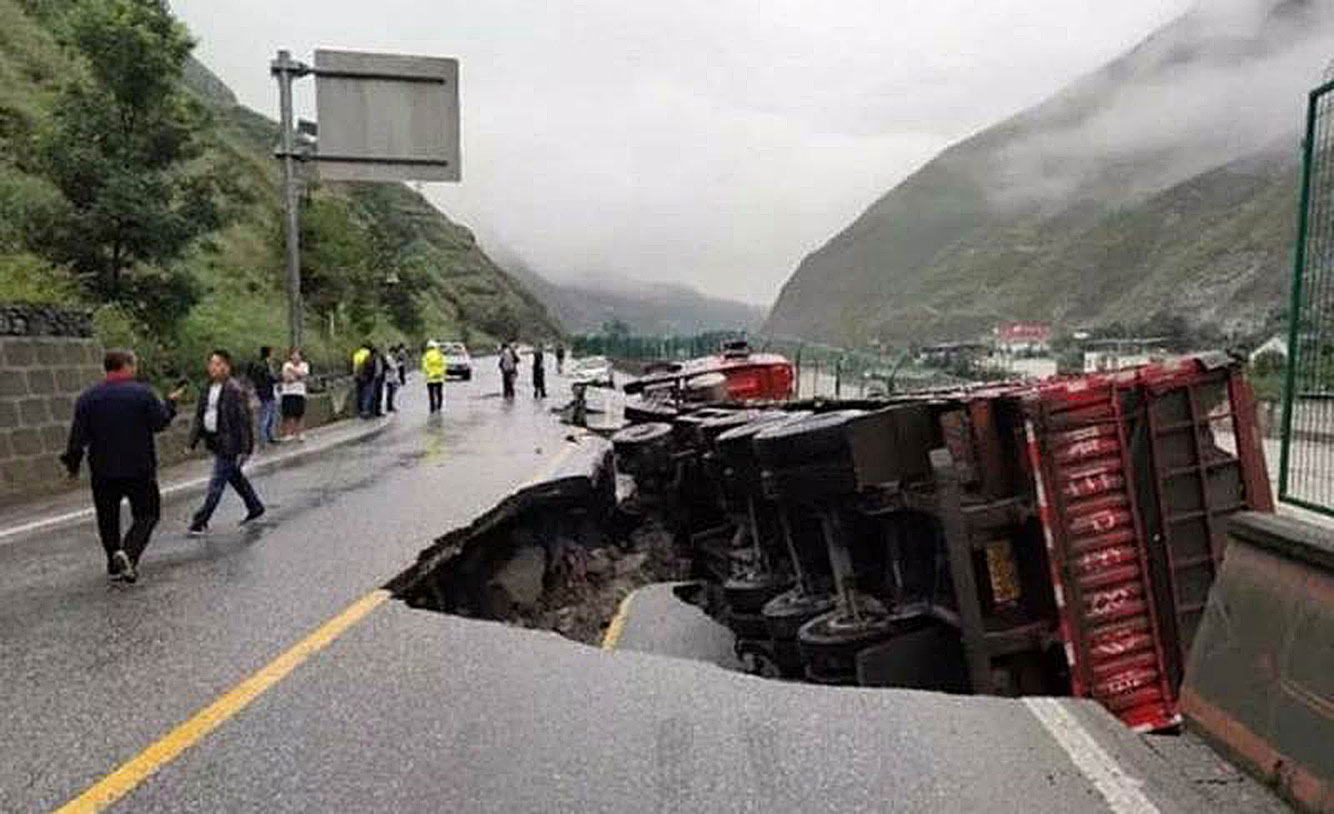
2018 saw increased flooding and torrential rains in Lhasa, Shigatse and other areas of central Tibet led to landslides, flooding and damage of infrastructure, making many roads impassable. Image from social media, obtained by the International Campaign for Tibet.

2018 saw increased flooding and torrential rains in Lhasa, Shigatse and other areas of central Tibet led to landslides, flooding and damage of infrastructure, making many roads impassable. Image from social media, obtained by the International Campaign for Tibet.
Rivers Without Boundaries notes that most hydropower capacity worldwide has been installed in China, creating considerable threats to some World Heritage properties, notably the Three Parallel Rivers in Yunnan. In the same paper, Simonov states: “Chinese state-owned engineering firms and banks seek hydropower opportunities overseas and still are involved in 70 percent[60] of hydropower projects completed globally, while China’s state banks provide 75 percent of global hydropower financing in 2017. This makes China, a member of [UNESCO’s] current World Heritage Committee, uniquely positioned to take a lead in making sure that hydropower does not negatively affect World Heritage world-wide.”
China’s historical lack of transparency and poor responsiveness to genuine environmental concerns raises serious challenges for related issues of dam construction and infrastructure building in and nearby the inscribed property. This is significant because the 2017 UNESCO report on the Three Parallel Rivers protected area says that “Pressure on the property primarily stems from infrastructure development,” as new constructions and increased access to the region alter the ecosystem.[61]
UNESCO is not alone in this assessment. Chinese scientists have also acknowledged the risks of unrestrained development in the area, saying in one paper: “[i]n recent years, with Shangri-la economic development, emerging eco-tourism development, large-scale water conservancy engineering and construction project starting, [the] ecological destruction problem is becoming more and more serious,” resulting in the decline of large forests and the degeneration of forests into “thickets, grassland and bare rock land.”[62]
Despite these concerns, the scale and pace of development in the region has been further accelerated to align with China’s strategic and economic objectives. The Tibet-China Power Network is one project designed to spur development. Operationalized in November 2018, the Tibet-China Power Network Project is an ultra-high voltage power grid project with “the largest altitude span in the world”[63] that connects the plateau to China’s electricity grid and supports the construction of the high-speed rail line from Chengdu to Lhasa. Dams in the Three Parallel Rivers property will help generate the energy needed to power the grid.[64]
Rivers Without Boundaries notes that most hydropower capacity worldwide has been installed in China, creating considerable threats to some World Heritage properties, notably the Three Parallel Rivers in Yunnan. In the same paper, Simonov states: “Chinese state-owned engineering firms and banks seek hydropower opportunities overseas and still are involved in 70 percent[60] of hydropower projects completed globally, while China’s state banks provide 75 percent of global hydropower financing in 2017. This makes China, a member of [UNESCO’s] current World Heritage Committee, uniquely positioned to take a lead in making sure that hydropower does not negatively affect World Heritage world-wide.”
China’s historical lack of transparency and poor responsiveness to genuine environmental concerns raises serious challenges for related issues of dam construction and infrastructure building in and nearby the inscribed property. This is significant because the 2017 UNESCO report on the Three Parallel Rivers protected area says that “Pressure on the property primarily stems from infrastructure development,” as new constructions and increased access to the region alter the ecosystem.[61]
UNESCO is not alone in this assessment. Chinese scientists have also acknowledged the risks of unrestrained development in the area, saying in one paper: “[i]n recent years, with Shangri-la economic development, emerging eco-tourism development, large-scale water conservancy engineering and construction project starting, [the] ecological destruction problem is becoming more and more serious,” resulting in the decline of large forests and the degeneration of forests into “thickets, grassland and bare rock land.”[62]
Despite these concerns, the scale and pace of development in the region has been further accelerated to align with China’s strategic and economic objectives. The Tibet-China Power Network is one project designed to spur development. Operationalized in November 2018, the Tibet-China Power Network Project is an ultra-high voltage power grid project with “the largest altitude span in the world”[63] that connects the plateau to China’s electricity grid and supports the construction of the high-speed rail line from Chengdu to Lhasa. Dams in the Three Parallel Rivers property will help generate the energy needed to power the grid.[64]
THE POLITICAL AGENDA BEHIND DAMMING THE DRICHU
THE POLITICAL AGENDA BEHIND DAMMING THE DRICHU
These dam projects are of high political importance to China because of their valuable water and hydropower energy resources, as well as their geographical positioning connecting Tibet and central China.[65] As a result, environmental protection concerns are secondary to President Xi’s political and economic interests, which treat the area as an important zone for nationality unity, and an integrated corridor linking the ‘Belt and Road’ and the ‘Yangtze River Economic Belt.[66]
Xi now has unprecedented power to impose his economic agenda. This increases the risks of over-reach, miscalculation and lack of accountability for mega-projects like the dams in Tibet.
The imperative of development and infrastructure construction in the western regions (in which Tibet is included) of the PRC was underlined at a recent meeting of the Central Comprehensive Reform Committee presided by Xi. The meeting reviewed and approved what was described as “A New Pattern of Western Development in the New Era,” in which the “One Belt, One Road” (also known as Belt and Road Initiative) connections with the Western regions and improving infrastructure are key.[67]
The Chinese leadership has also aggressively sought to enlist the U.N.’s support for the Belt and Road Initiative just as Beijing faces growing criticism for imposing unsustainable debt burdens on poor countries with BRI and using the strategy to project China’s economic and military interests and influence globally. China has even sought to make headway convincing key UN officials and a number of diplomats that the BRI is closely aligned with the 2030 Agenda and that their “synergies” charted a path forward to achieving the 2030 Agenda’s Sustainable Development Goals (SDGs). In an analysis for Sinopsis.cn, Andrea Worden points out: “Recently, however the UN Human Rights Council (HRC) has taken concrete steps to operationalize the widely held view that the 2030 Agenda can only be achieved through a human rights-based approach, which takes into account all human rights. A growing focus on the inextricable linkages between the SDGs and human rights not only runs counter to China’s ‘development first’ theory of human rights, but also raises questions about China’s ongoing efforts to cast the BRI as synergistic with the 2030 Agenda.”[68]
These dam projects are of high political importance to China because of their valuable water and hydropower energy resources, as well as their geographical positioning connecting Tibet and central China.[65] As a result, environmental protection concerns are secondary to President Xi’s political and economic interests, which treat the area as an important zone for nationality unity, and an integrated corridor linking the ‘Belt and Road’ and the ‘Yangtze River Economic Belt.[66]
Xi now has unprecedented power to impose his economic agenda. This increases the risks of over-reach, miscalculation and lack of accountability for mega-projects like the dams in Tibet.
The imperative of development and infrastructure construction in the western regions (in which Tibet is included) of the PRC was underlined at a recent meeting of the Central Comprehensive Reform Committee presided by Xi. The meeting reviewed and approved what was described as “A New Pattern of Western Development in the New Era,” in which the “One Belt, One Road” (also known as Belt and Road Initiative) connections with the Western regions and improving infrastructure are key.[67]
The Chinese leadership has also aggressively sought to enlist the U.N.’s support for the Belt and Road Initiative just as Beijing faces growing criticism for imposing unsustainable debt burdens on poor countries with BRI and using the strategy to project China’s economic and military interests and influence globally. China has even sought to make headway convincing key UN officials and a number of diplomats that the BRI is closely aligned with the 2030 Agenda and that their “synergies” charted a path forward to achieving the 2030 Agenda’s Sustainable Development Goals (SDGs). In an analysis for Sinopsis.cn, Andrea Worden points out: “Recently, however the UN Human Rights Council (HRC) has taken concrete steps to operationalize the widely held view that the 2030 Agenda can only be achieved through a human rights-based approach, which takes into account all human rights. A growing focus on the inextricable linkages between the SDGs and human rights not only runs counter to China’s ‘development first’ theory of human rights, but also raises questions about China’s ongoing efforts to cast the BRI as synergistic with the 2030 Agenda.”[68]
RECOMMENDATIONS
China’s historical lack of transparency and poor responsiveness to genuine environmental concerns raises serious challenges for related issues of dam construction and infrastructure building in and nearby the inscribed property, the Three Parallel Rivers. This is significant because the 2017 UNESCO report on the area argues that “Pressure on the property primarily stems from infrastructure development,” as new construction and increased access to the region alter the ecosystem.”[69] UNESCO World Heritage has also clearly stated its concerns about infrastructure construction “outside the ‘commitment area’” impacting the Three Parallel Rivers property.
China seeks to use UNESCO World Heritage status as branding to promote tourism and lend legitimacy to its policies.[70] As one analysis notes, “The Chinese Party state thus uses international organizations such as the UNESCO and its inherent discourses and narratives to legitimize domestic political objectives.”[71] Professor Marina Svensson of Lund University underlined this in a further paper, cited in the same source as above, writing: “The official Chinese heritage discourse still serves to justify the rule of the Communist Party and its interpretation of history. It is expressed in different policies and laws, and in the selection of protected heritage sites at national, provincial, district and county levels.”[72]
Given the evidence presented in this report, it is imperative that the UNESCO World Heritage Committee use the opportunity of the 43rd Session in June and July 2019 to address the number and type of proposed dams in the property and its buffer area in the current Five-Year Plan period until 2020 and beyond.
- The Chinese government should stop hydropower projects that pose a serious threat to the sensitive environment in Tibet, including the Longpan power station in Yunnan, and also prevent relocations of Tibetans or any other affected group that are connected to such hydropower projects.
- The UNESCO World Heritage Committee should decide to send a Reactive Monitoring mission from the relevant Advisory Bodies or other organizations to visit the property of “Three Parallel Rivers of Yunnan”, evaluate the nature and extent of the threats as indicated in this report and propose effective measures to be taken, in accordance with the UNESCO Operational Guidelines.
In particular, this mission should ascertain whether the site is faced with specific and proven imminent danger, or faced with major threats which could have deleterious effects on its inherent characteristics. such as, but not exclusively, in view of Article 180 UNESCO Operational Guidelines, - A serious decline in the population of the endangered species or the other species of Outstanding Universal Value for which the property was legally established to protect;
- severe deterioration of the natural beauty or scientific value of the property, as by construction of reservoirs which flood important parts of the property, industrial development, major public works, mining, pollution, logging;
- planned resettlement or development projects within the property or so situated that the impacts threaten the property;
- threatening impacts of climatic, geological or other environmental factors.
- The UNESCO World Heritage Committee must seek to ensure that local Tibetans and residents are not displaced due to infrastructure construction, mass tourism or other development projects. The UNESCO World Heritage Committee should also urge the Chinese state party to uphold the principle of free, prior and informed consent in relation to all decisions over development of resources in the ‘Three Parallel Rivers’ property. The rights of Tibetans, who play fundamental roles as the guardians of healthy rivers, must be respected.
- The UNESCO World Heritage Committee should ensure the Chinese state upholds accurate reporting practices and promptly informs UNESCO of planned infrastructure plans in the areas in or nearby protected areas. This is a serious concern as past state reports have revealed repeated cases of intransparency. Failure to accurately report information should result in changes to oversight mechanisms, for example inspection of the protected site and nearby regions by UNESCO.
- UNESCO should continue to promote the adoption of a holistic strategy to managing development and conservation projects in the Three Parallel Rivers region. This is necessary as the Chinese state still views conservation and development as spatially separate and distinct issues that do not impact each other. This has been evidenced by the creation of an inscribed property that is separated into clusters with mines and dams either in between clusters or in close proximity to the protected area and buffer zone.
- The UNESCO World Heritage Committee should also be persistent in pressing for regular and rigorous scrutiny of the dam-building process to ensure sufficient scientific knowledge exists to support evidence-based environmental impact assessments (EIA), and that EIAs are completed before construction begins. This is a serious concern, as the Chinese state, itself, has acknowledged in its 2018 state of conservation report, that it is unable to conduct “relatively accurate environmental impact assessment[s]” because of insufficient knowledge of the property’s ecosystem, biological diversity, and wildlife population.
The International Campaign for Tibet joins the Rivers Without Borders coalition and World Heritage Watch in calling on governments, international financial institutions and the International Hydropower Association who met in Paris last week to do the following:
- Steer priorities, investments and financial incentives away from additional hydroelectric projects and toward energy efficiency and truly sustainable renewable energy options (solar, wind and biomass and, when appropriate, micro-hydro). Special attention should be given to opportunities for technological innovation, decentralized generation and improving energy access among isolated, off-grid communities.
- Eliminate financial incentives for new hydroelectric projects within climate change mechanisms, such as the Green Climate Fund and Nationally Determined Contributions, and within programs to promote implementation of the UN Sustainable Development Goals (with the possible exception of micro-hydro projects).
- Commission independent audits of controversial existing dam projects and basin-wide cascades in terms of their social and environmental consequences, identifying steps to mitigate impacts and ensure just reparations for affected communities, based on direct consultations. When such measures are prohibitively expensive or otherwise inviable, the de-commissioning of dam projects should be undertaken.
- Ensure the alignment of operational procedures for existing hydroprojects with relevant territorial plans at the basin level, such as integrated water resource management and protected areas that ensure key ecological processes and the rights of local communities, based on the concepts and tools of participatory, adaptive management.
- Ensure that renewable energy policies and projects adopt, across the board, robust guidelines to safeguard human rights and environmental protections, such as ILO Convention 169 and the UN Principles on Business and Human Rights. No energy facilities that potentially impact the territories and livelihoods of indigenous people and other traditional communities should be authorized without obtaining the free, prior and informed consent of the community and ensuring the cooperative design of co-management strategies.
RECOMMENDATIONS
China’s historical lack of transparency and poor responsiveness to genuine environmental concerns raises serious challenges for related issues of dam construction and infrastructure building in and nearby the inscribed property, the Three Parallel Rivers. This is significant because the 2017 UNESCO report on the area argues that “Pressure on the property primarily stems from infrastructure development,” as new construction and increased access to the region alter the ecosystem.”[69] UNESCO World Heritage has also clearly stated its concerns about infrastructure construction “outside the ‘commitment area’” impacting the Three Parallel Rivers property.
China seeks to use UNESCO World Heritage status as branding to promote tourism and lend legitimacy to its policies.[70] As one analysis notes, “The Chinese Party state thus uses international organizations such as the UNESCO and its inherent discourses and narratives to legitimize domestic political objectives.”[71] Professor Marina Svensson of Lund University underlined this in a further paper, cited in the same source as above, writing: “The official Chinese heritage discourse still serves to justify the rule of the Communist Party and its interpretation of history. It is expressed in different policies and laws, and in the selection of protected heritage sites at national, provincial, district and county levels.”[72]
Given the evidence presented in this report, it is imperative that the UNESCO World Heritage Committee use the opportunity of the 43rd Session in June and July 2019 to address the number and type of proposed dams in the property and its buffer area in the current Five-Year Plan period until 2020 and beyond.
- The Chinese government should stop hydropower projects that pose a serious threat to the sensitive environment in Tibet, including the Longpan power station in Yunnan, and also prevent relocations of Tibetans or any other affected group that are connected to such hydropower projects.
- The UNESCO World Heritage Committee should decide to send a Reactive Monitoring mission from the relevant Advisory Bodies or other organizations to visit the property of “Three Parallel Rivers of Yunnan”, evaluate the nature and extent of the threats as indicated in this report and propose effective measures to be taken, in accordance with the UNESCO Operational Guidelines.
In particular, this mission should ascertain whether the site is faced with specific and proven imminent danger, or faced with major threats which could have deleterious effects on its inherent characteristics. such as, but not exclusively, in view of Article 180 UNESCO Operational Guidelines,- A serious decline in the population of the endangered species or the other species of Outstanding Universal Value for which the property was legally established to protect;
- severe deterioration of the natural beauty or scientific value of the property, as by construction of reservoirs which flood important parts of the property, industrial development, major public works, mining, pollution, logging;
- planned resettlement or development projects within the property or so situated that the impacts threaten the property;
- threatening impacts of climatic, geological or other environmental factors.
- The UNESCO World Heritage Committee must seek to ensure that local Tibetans and residents are not displaced due to infrastructure construction, mass tourism or other development projects. The UNESCO World Heritage Committee should also urge the Chinese state party to uphold the principle of free, prior and informed consent in relation to all decisions over development of resources in the ‘Three Parallel Rivers’ property. The rights of Tibetans, who play fundamental roles as the guardians of healthy rivers, must be respected.
- The UNESCO World Heritage Committee should ensure the Chinese state upholds accurate reporting practices and promptly informs UNESCO of planned infrastructure plans in the areas in or nearby protected areas. This is a serious concern as past state reports have revealed repeated cases of intransparency. Failure to accurately report information should result in changes to oversight mechanisms, for example inspection of the protected site and nearby regions by UNESCO.
- UNESCO should continue to promote the adoption of a holistic strategy to managing development and conservation projects in the Three Parallel Rivers region. This is necessary as the Chinese state still views conservation and development as spatially separate and distinct issues that do not impact each other. This has been evidenced by the creation of an inscribed property that is separated into clusters with mines and dams either in between clusters or in close proximity to the protected area and buffer zone.
- The UNESCO World Heritage Committee should also be persistent in pressing for regular and rigorous scrutiny of the dam-building process to ensure sufficient scientific knowledge exists to support evidence-based environmental impact assessments (EIA), and that EIAs are completed before construction begins. This is a serious concern, as the Chinese state, itself, has acknowledged in its 2018 state of conservation report, that it is unable to conduct “relatively accurate environmental impact assessment[s]” because of insufficient knowledge of the property’s ecosystem, biological diversity, and wildlife population.
The International Campaign for Tibet joins the Rivers Without Borders coalition and World Heritage Watch in calling on governments, international financial institutions and the International Hydropower Association who met in Paris last week to do the following:
- Steer priorities, investments and financial incentives away from additional hydroelectric projects and toward energy efficiency and truly sustainable renewable energy options (solar, wind and biomass and, when appropriate, micro-hydro). Special attention should be given to opportunities for technological innovation, decentralized generation and improving energy access among isolated, off-grid communities.
- Eliminate financial incentives for new hydroelectric projects within climate change mechanisms, such as the Green Climate Fund and Nationally Determined Contributions, and within programs to promote implementation of the UN Sustainable Development Goals (with the possible exception of micro-hydro projects).
- Commission independent audits of controversial existing dam projects and basin-wide cascades in terms of their social and environmental consequences, identifying steps to mitigate impacts and ensure just reparations for affected communities, based on direct consultations. When such measures are prohibitively expensive or otherwise inviable, the de-commissioning of dam projects should be undertaken.
- Ensure the alignment of operational procedures for existing hydroprojects with relevant territorial plans at the basin level, such as integrated water resource management and protected areas that ensure key ecological processes and the rights of local communities, based on the concepts and tools of participatory, adaptive management.
- Ensure that renewable energy policies and projects adopt, across the board, robust guidelines to safeguard human rights and environmental protections, such as ILO Convention 169 and the UN Principles on Business and Human Rights. No energy facilities that potentially impact the territories and livelihoods of indigenous people and other traditional communities should be authorized without obtaining the free, prior and informed consent of the community and ensuring the cooperative design of co-management strategies.
PHOTOGRAPHS & MAPS
PHOTOGRAPHS & MAPS
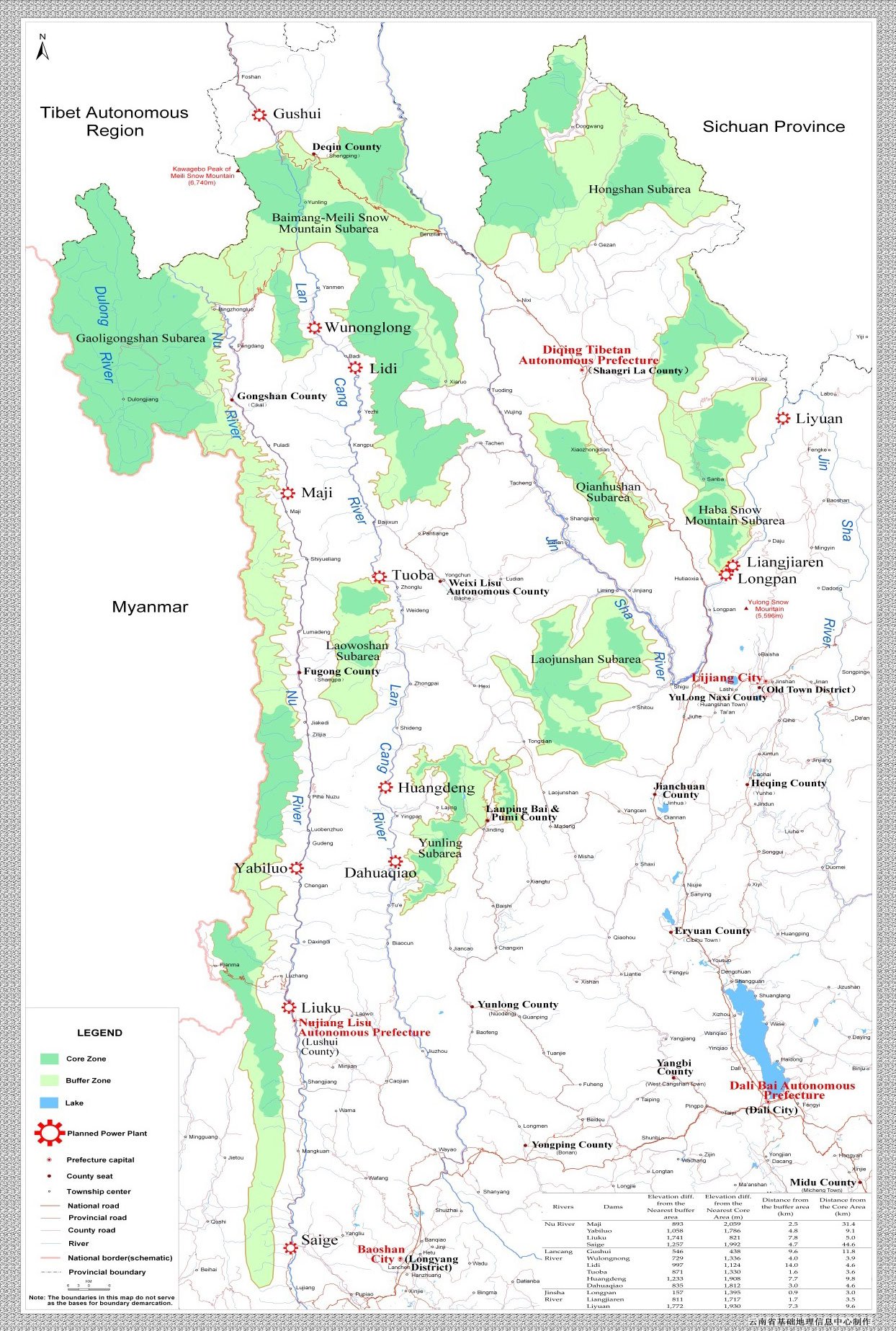
Hydropower dams proposed and under construction in the UNESCO Three Parallel Rivers property and surrounding areas. (Source: China’s response to UNESCO’s 2017 State of Conservation queries: http://whc.unesco.org/en/list/1083/documents)

Hydropower dams proposed and under construction in the UNESCO Three Parallel Rivers property and surrounding areas. (Source: China’s response to UNESCO’s 2017 State of Conservation queries: http://whc.unesco.org/en/list/1083/documents)
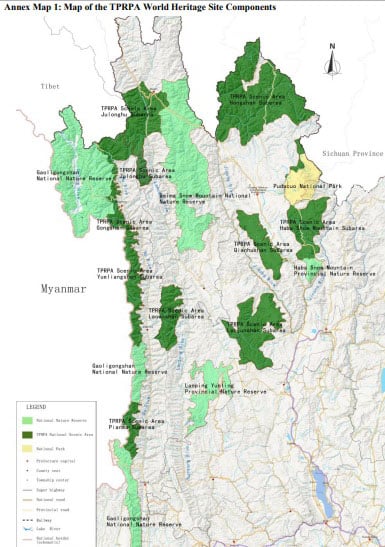
Map produced by the PRC of the UNESCO Three Parallel Rivers area, Yunnan. (Source: China’s response to UNESCO’s 2017 State of Conservation queries: http://whc.unesco.org/en/list/1083/documents)

Map produced by the PRC of the UNESCO Three Parallel Rivers area, Yunnan. (Source: China’s response to UNESCO’s 2017 State of Conservation queries: http://whc.unesco.org/en/list/1083/documents)
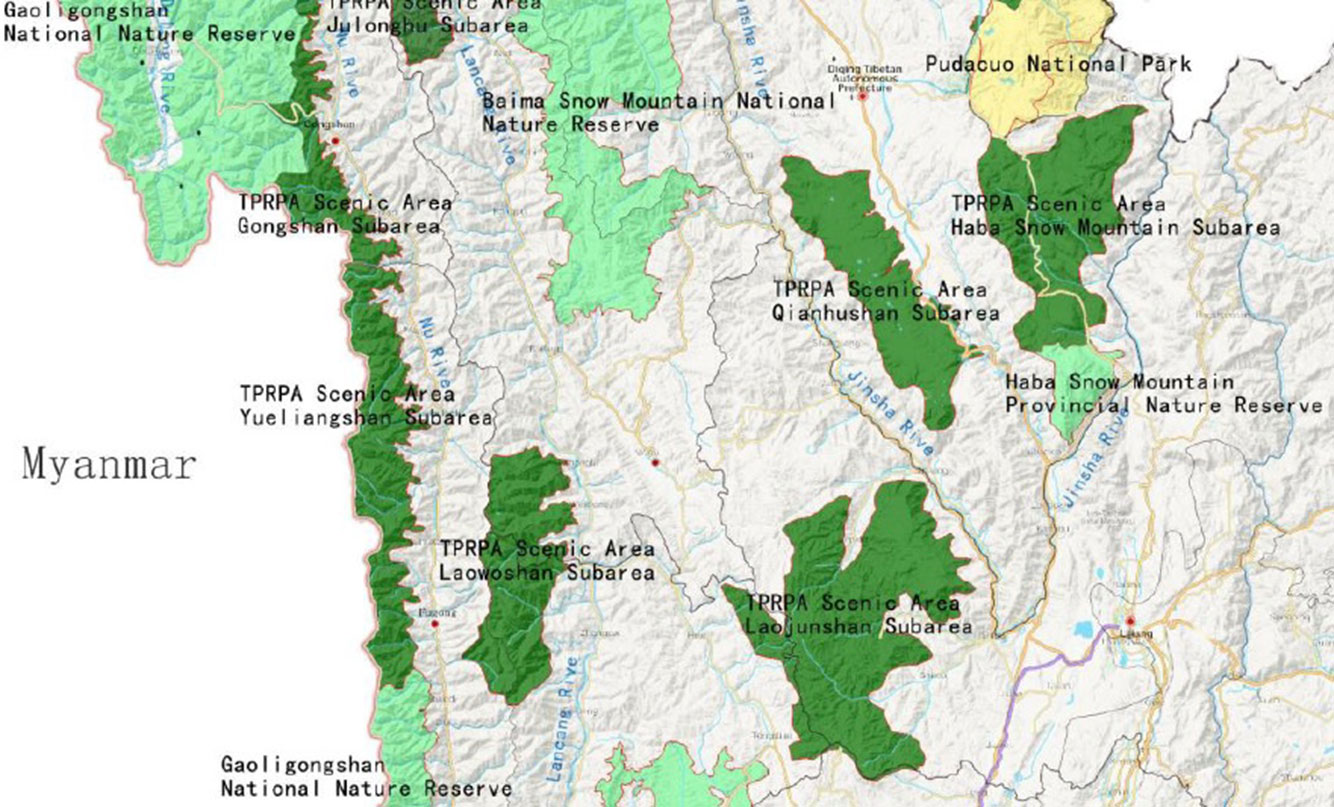
A map showing the fragmented patchwork of the Three Parallel Rivers UNESCO property. (Source: China’s response to UNESCO’s 2017 State of Conservation queries: http://whc.unesco.org/en/list/1083/documents)

A map showing the fragmented patchwork of the Three Parallel Rivers UNESCO property. (Source: China’s response to UNESCO’s 2017 State of Conservation queries: http://whc.unesco.org/en/list/1083/documents)
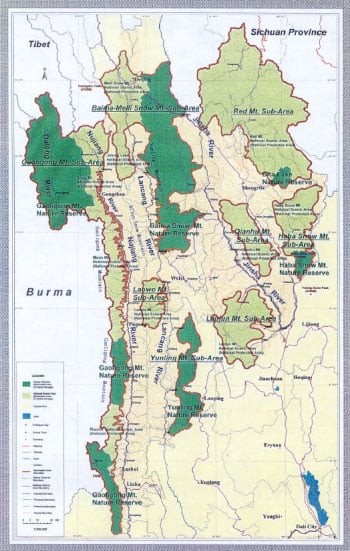
Three Parallel Rivers UNESCO World Heritage area, site map in English. (Source: China’s response to UNESCO’s 2017 State of Conservation queries: http://whc.unesco.org/en/list/1083/documents)

Three Parallel Rivers UNESCO World Heritage area, site map in English. (Source: China’s response to UNESCO’s 2017 State of Conservation queries: http://whc.unesco.org/en/list/1083/documents)
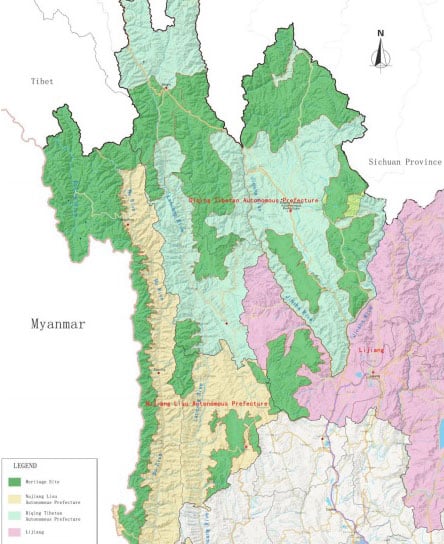
Parallel Rivers area showing prefectures, 2018. (Source: China’s response to UNESCO’s 2017 State of Conservation queries: http://whc.unesco.org/en/list/1083/documents)

Parallel Rivers area showing prefectures, 2018. (Source: China’s response to UNESCO’s 2017 State of Conservation queries: http://whc.unesco.org/en/list/1083/documents)
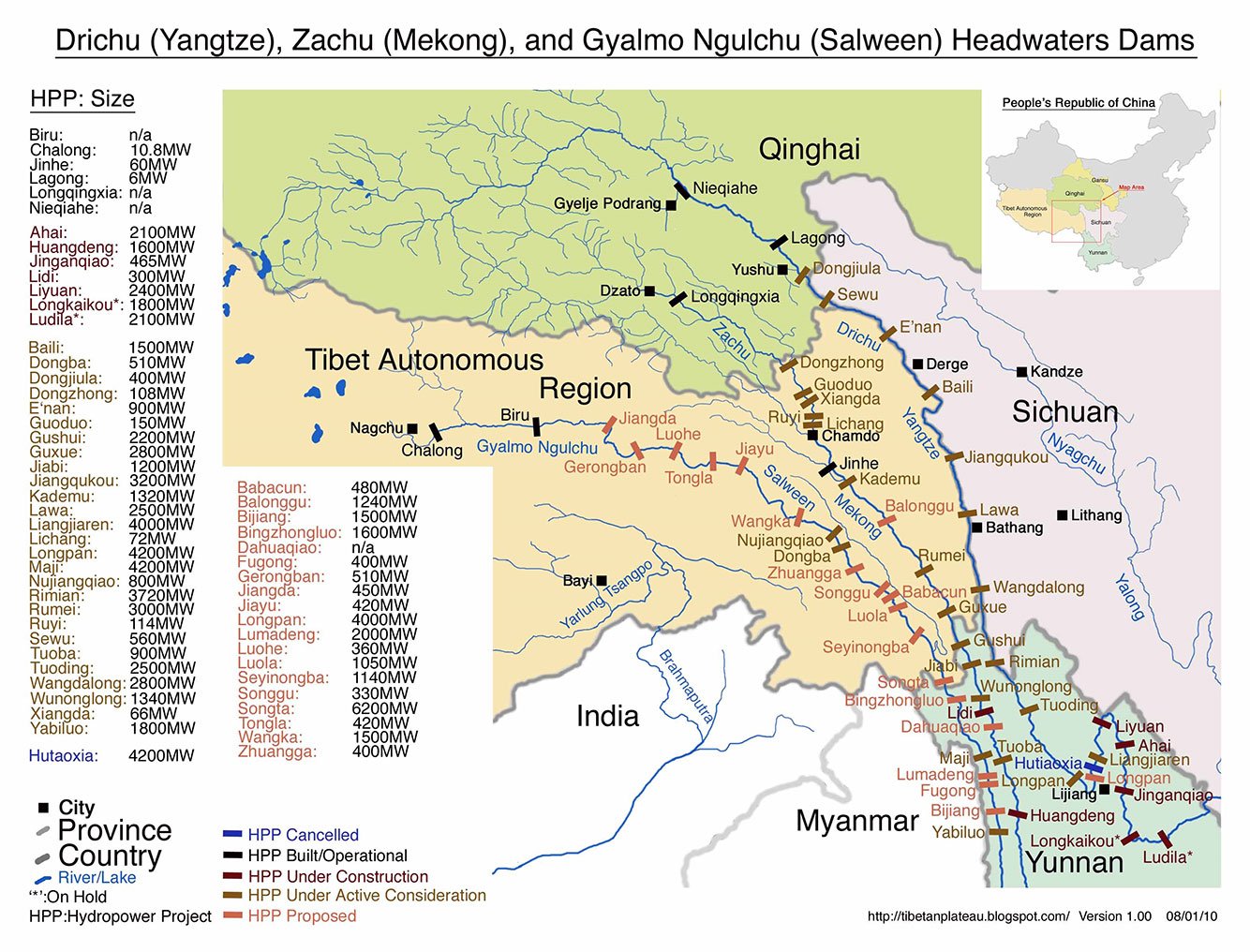
A detailed map of the watersheds of the Drichu (Yangtze), Machu (Yellow) and Gyalmo Ngulchu (Salween) and dam locations during the 12th Five Year Plan period. Prepared by Tashi Tsering on www.tibetanplateau.blogspot.co.uk.

A detailed map of the watersheds of the Drichu (Yangtze), Machu (Yellow) and Gyalmo Ngulchu (Salween) and dam locations during the 12th Five Year Plan period. Prepared by Tashi Tsering on www.tibetanplateau.blogspot.co.uk.
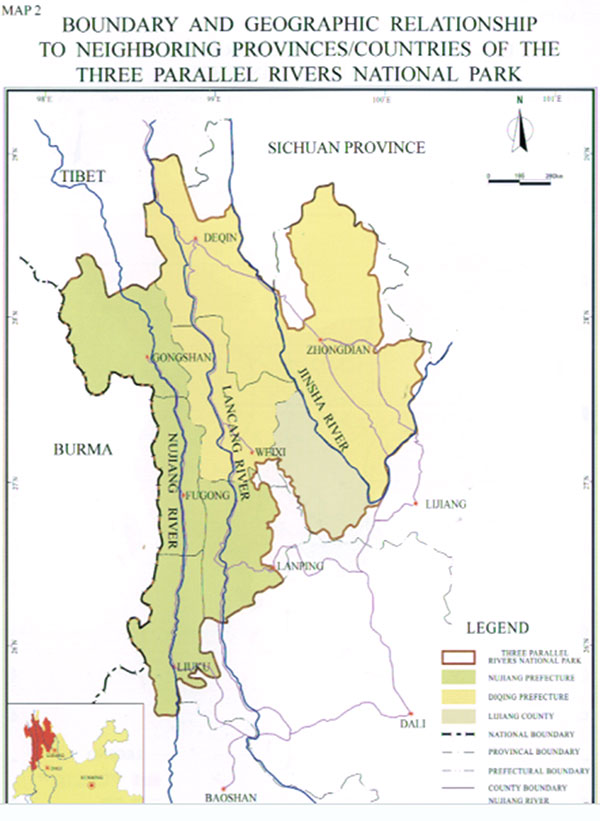
Map showing the borders of the Three Parallel Rivers area. (Source: China’s response to UNESCO’s 2017 State of Conservation queries: http://whc.unesco.org/en/list/1083/documents)

Map showing the borders of the Three Parallel Rivers area. (Source: China’s response to UNESCO’s 2017 State of Conservation queries: http://whc.unesco.org/en/list/1083/documents)
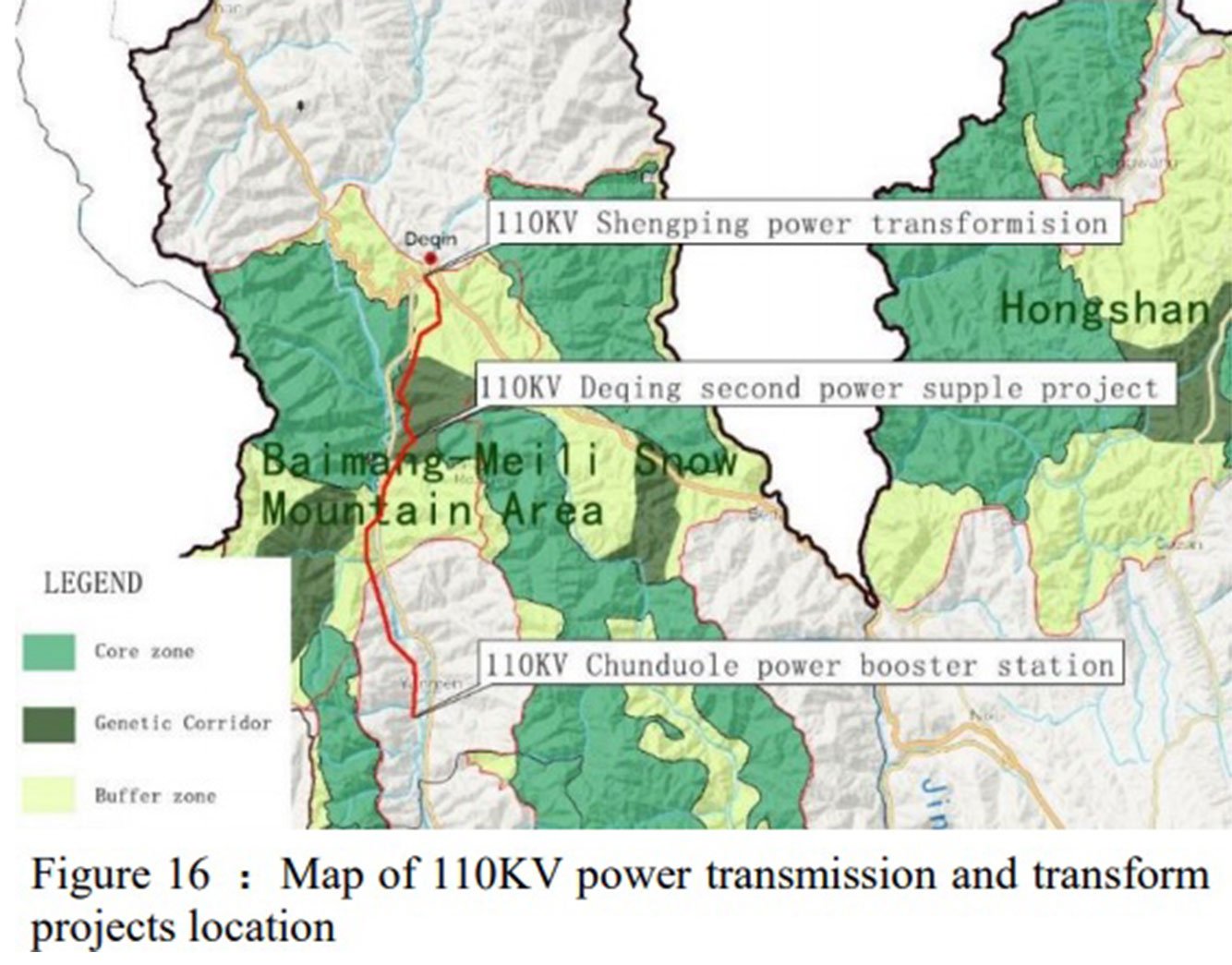
Power grid map across Three Parallel Rivers area in Dechen (Chinese: Diqing), Yunnan, 2018.

Power grid map across Three Parallel Rivers area in Dechen (Chinese: Diqing), Yunnan, 2018.
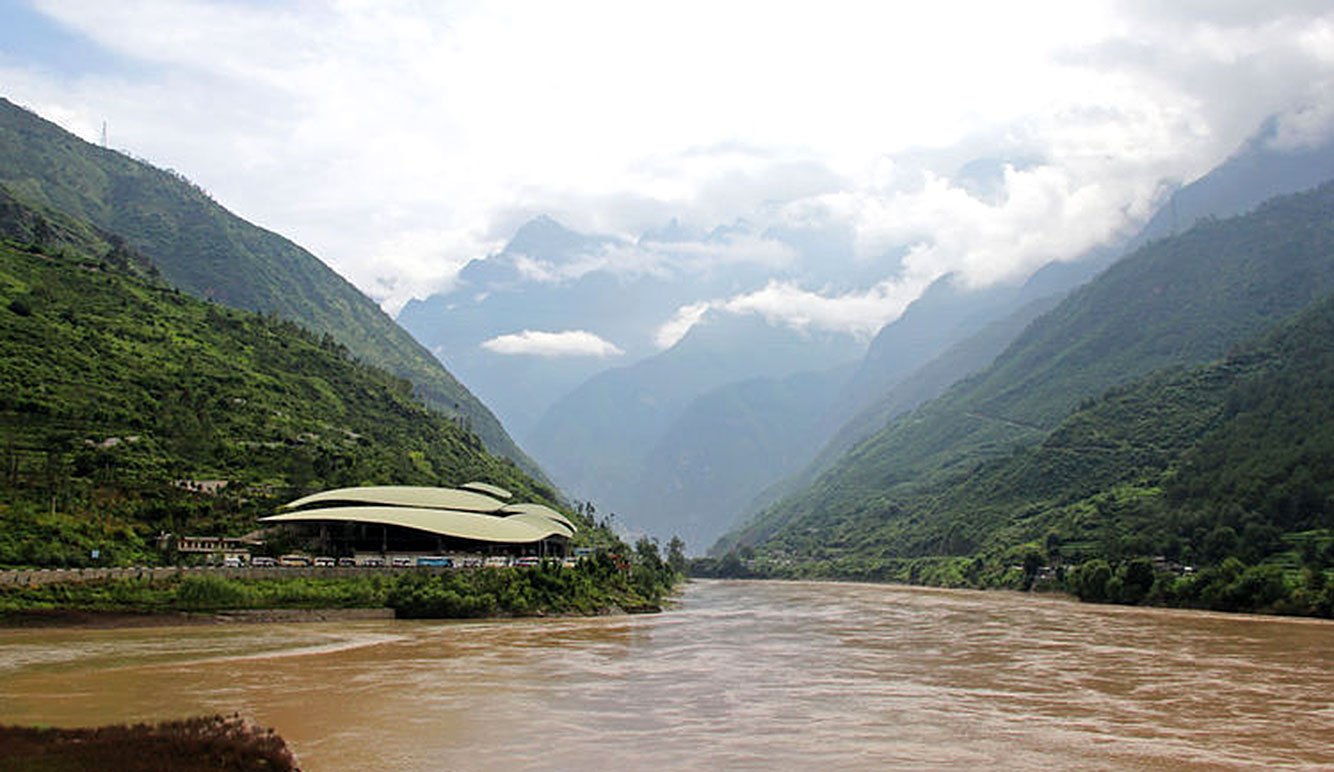
View of the bus park for tourist coaches at Tiger Leaping Gorge.

View of the bus park for tourist coaches at Tiger Leaping Gorge.
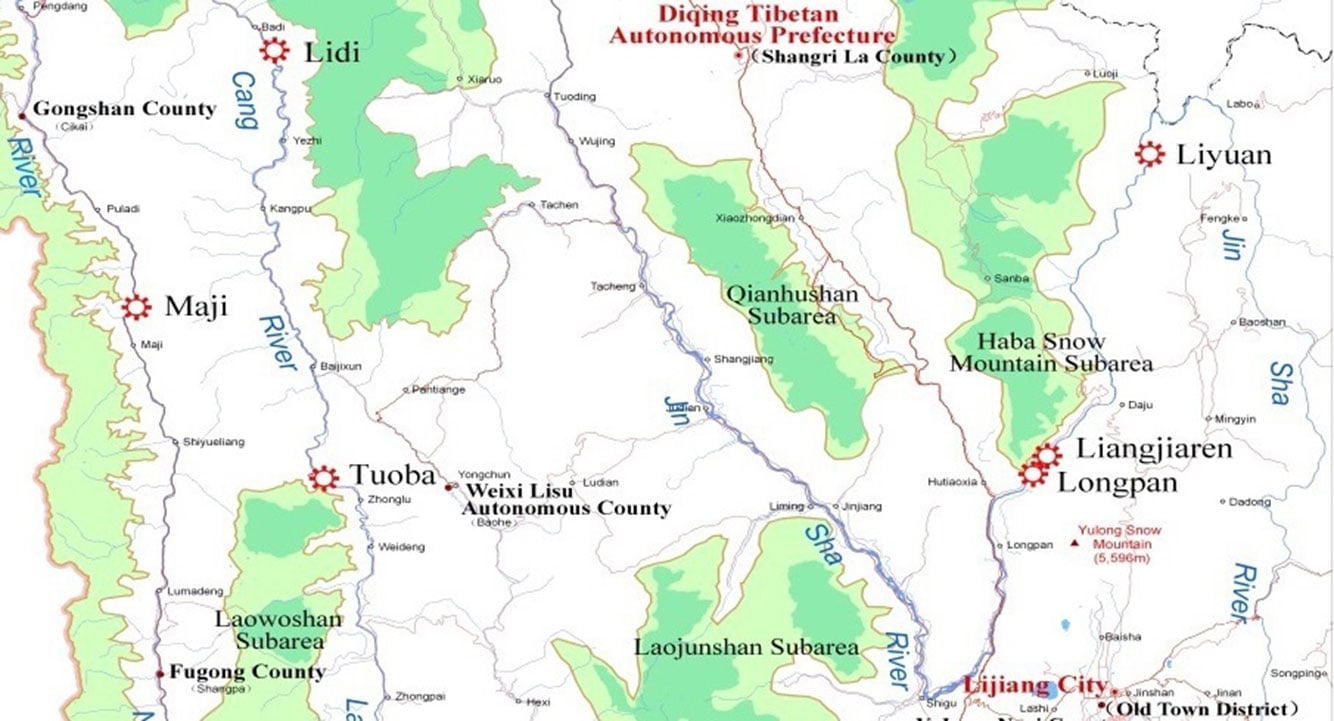
Map showing the location of the Longpan dam across Tiger Leaping Gorge.

Map showing the location of the Longpan dam across Tiger Leaping Gorge.
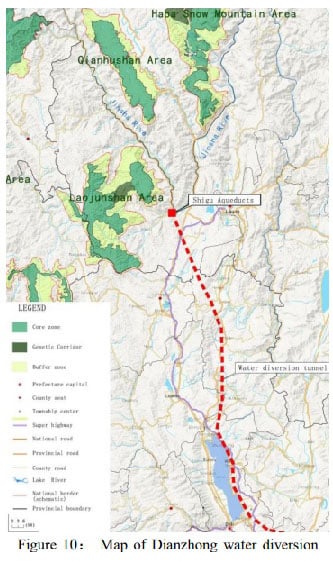
Map of the diversion of the Drichu mentioned in the Chinese state Party’s response to UNESCO. Water diversion projects particularly on this scale cause an array of negative impacts such as disruption of rivers’ natural flow, disconnection of a single river ecosystem, change in habitats of species, changes in sediment flow and channel processes. From the website: https://www.gokunming.com/en/blog/item/3594/china-initiates-enormous-yangtze-water-diversion-scheme

Map of the diversion of the Drichu mentioned in the Chinese state Party’s response to UNESCO. Water diversion projects particularly on this scale cause an array of negative impacts such as disruption of rivers’ natural flow, disconnection of a single river ecosystem, change in habitats of species, changes in sediment flow and channel processes. From the website: https://www.gokunming.com/en/blog/item/3594/china-initiates-enormous-yangtze-water-diversion-scheme
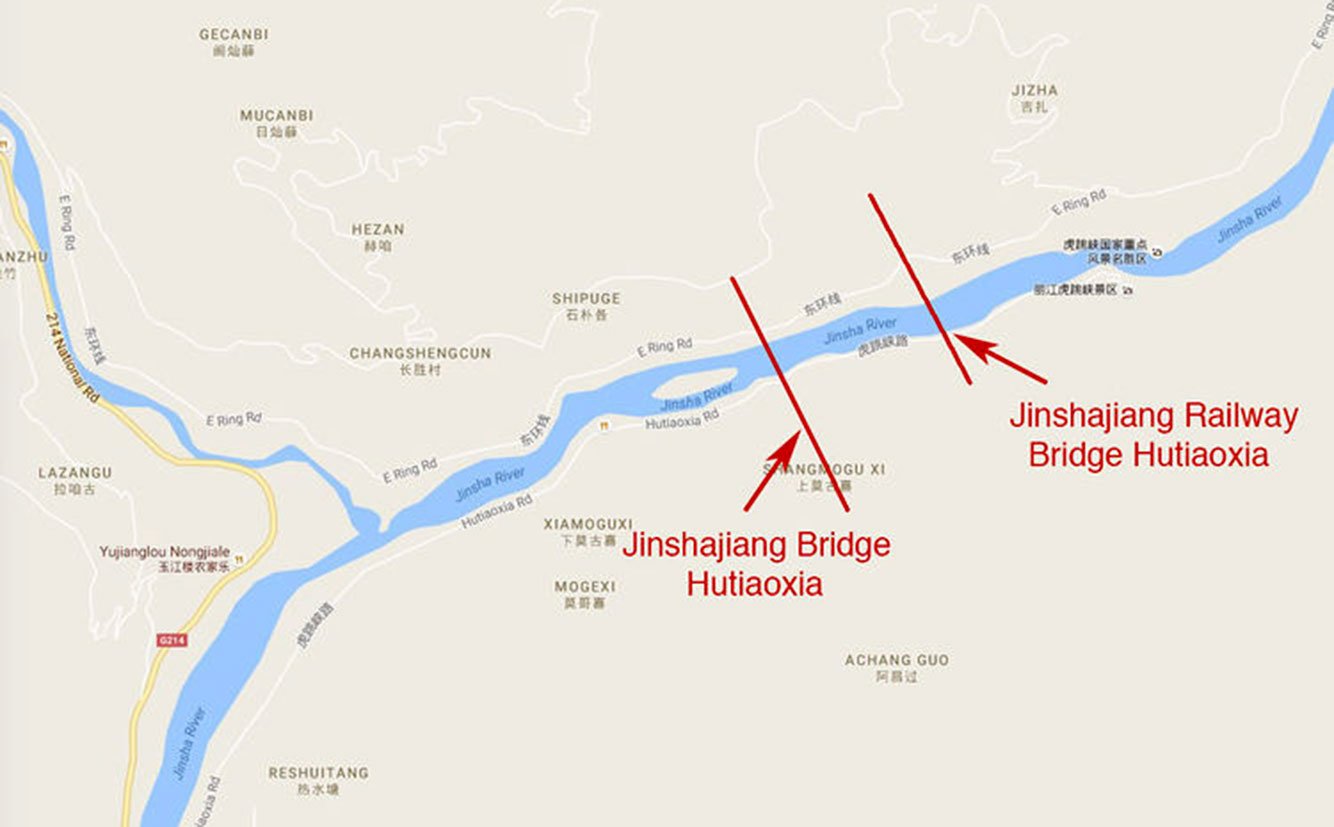
Graphic showing the expressway and rail bridge at Tiger Leaping Gorge. (Source: Eric Sakowski http://highestbridges.com/wiki/index.php?title=2018_High_Bridge_Trip_Photo_Album)

Graphic showing the expressway and rail bridge at Tiger Leaping Gorge. (Source: Eric Sakowski http://highestbridges.com/wiki/index.php?title=2018_High_Bridge_Trip_Photo_Album)
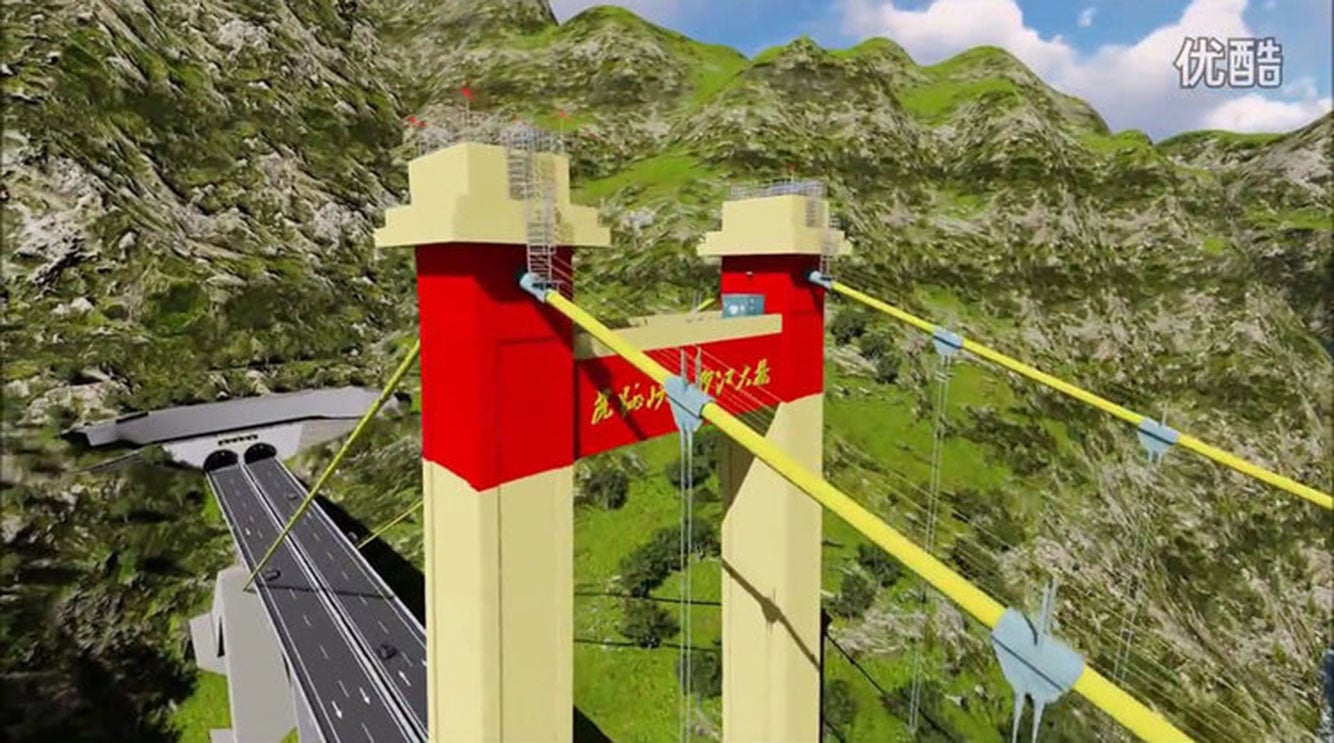
Design for expressway across Tiger Leaping Gorge. (Source: Eric Sakowski http://highestbridges.com/wiki/index.php?title=2018_High_Bridge_Trip_Photo_Album)

Design for expressway across Tiger Leaping Gorge. (Source: Eric Sakowski http://highestbridges.com/wiki/index.php?title=2018_High_Bridge_Trip_Photo_Album)
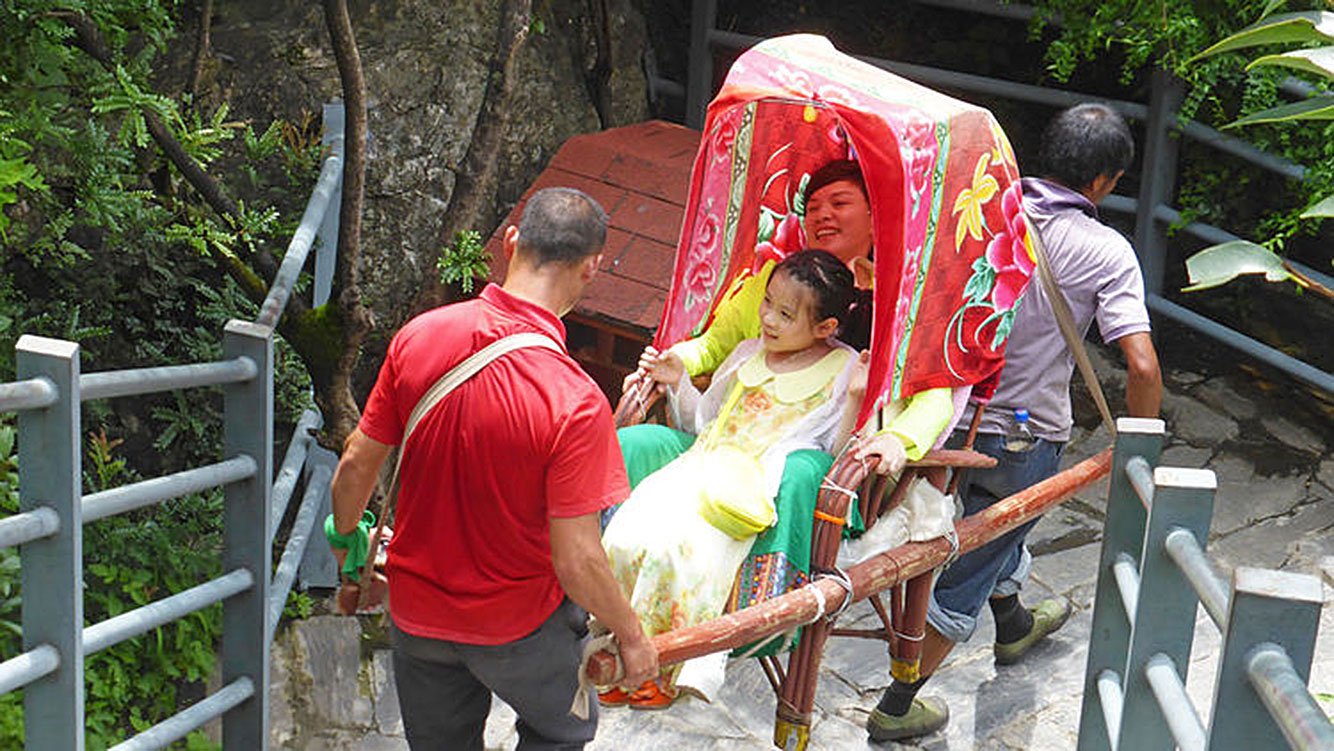
Tourists visiting Tiger Leaping Gorge can be portered down from the viewing platform. Photo used on Gabriel Lafitte’s blog, http://rukor.org/tiger-leaping-concrete-damming/

Tourists visiting Tiger Leaping Gorge can be portered down from the viewing platform. Photo used on Gabriel Lafitte’s blog, http://rukor.org/tiger-leaping-concrete-damming/
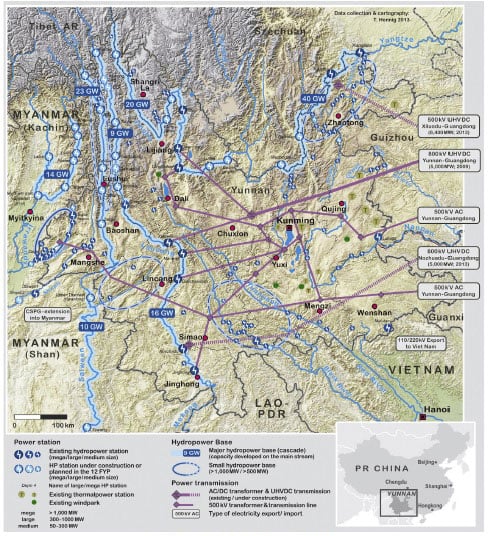
Yunnan dams and grid map, 2013. Credit: ‘Review of Yunnan’s hydropower development’ by Thomas Hennig, Wenling Wang, Yan Feng, Xiaokun, Daming He,, Marburg University, Renewable and Sustainable Energy Reviews 27 (2013) 585–595.

Yunnan dams and grid map, 2013. Credit: ‘Review of Yunnan’s hydropower development’ by Thomas Hennig, Wenling Wang, Yan Feng, Xiaokun, Daming He,, Marburg University, Renewable and Sustainable Energy Reviews 27 (2013) 585–595.
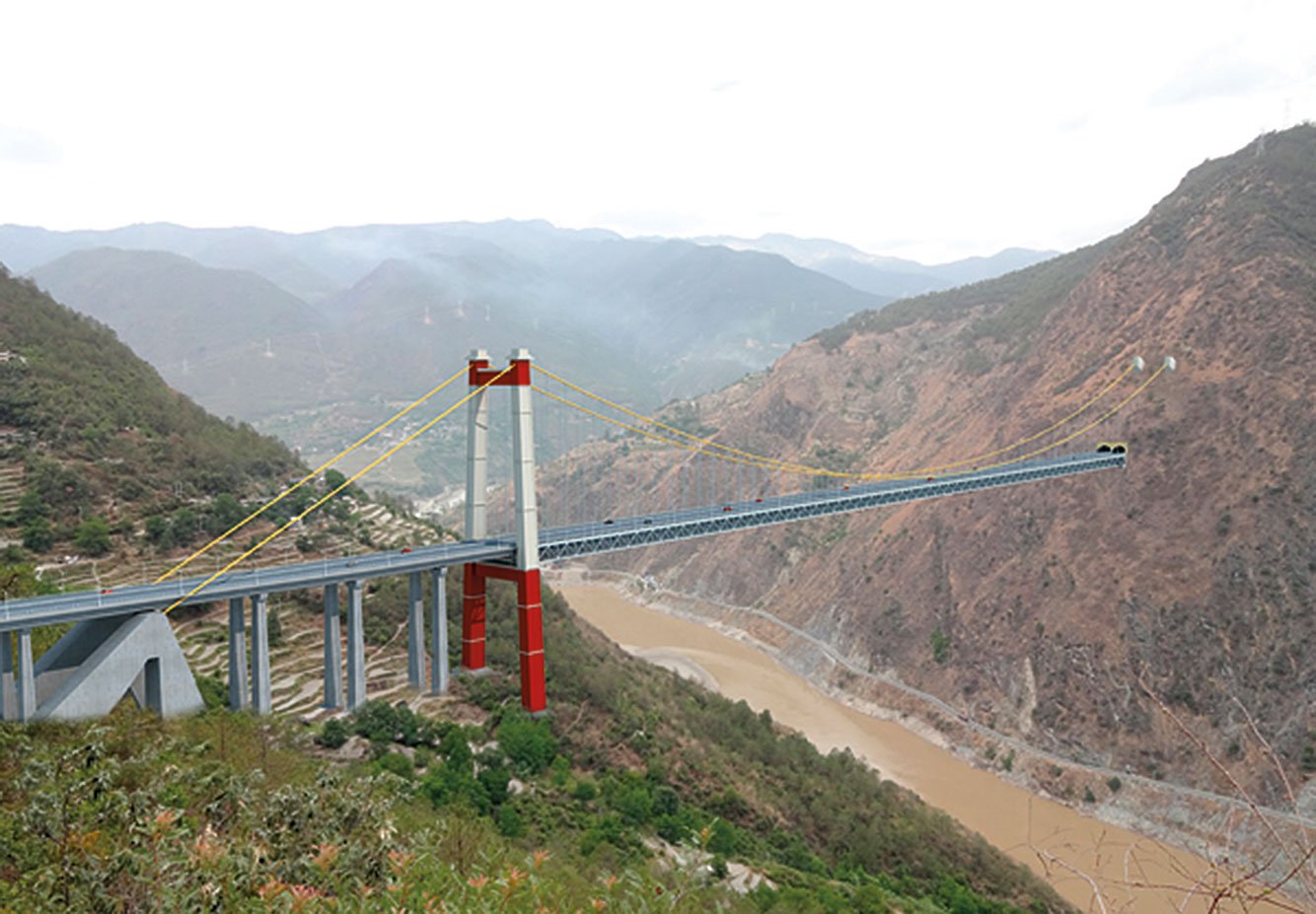
Design for bridging the Drichu from Tiger Leaping Gorge.

Design for bridging the Drichu from Tiger Leaping Gorge.
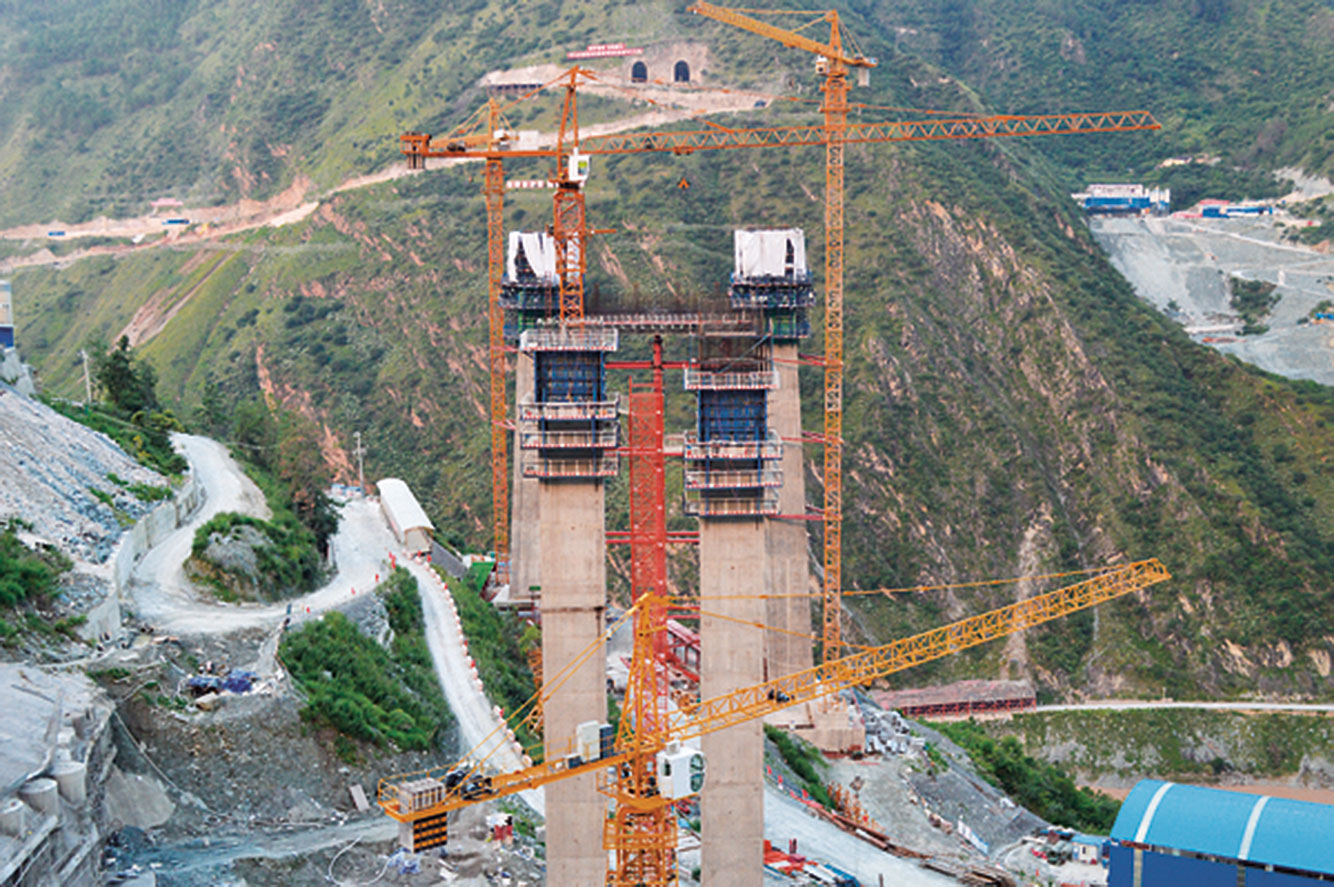
Infrastructure construction for bridging the Drichu at Tiger Leaping Gorge.

Infrastructure construction for bridging the Drichu at Tiger Leaping Gorge.
Footnotes:
[1] Website of the State-owned Assets Supervision and Administration Commission of the State Council, November 30, 2018, ‘World’s hardest power grid project operates in Tibet’, http://en.sasac.gov.cn/2018/11/30/c_676.htm.
[2] See his biography on China Vitae: http://www.chinavitae.com/biography/Liu_Zhenya
[3] Geidco website with further details is at: http://www.geidco.org/html/qqnyhlwen/col2017080766/column_2017080766_1.html
[4] In 2011, China’s highest government body for the first time officially acknowledged the “urgent problems” of the Three Gorges Dam. International Rivers Network blog by Peter Bosshard, May 19, 2011, https://www.internationalrivers.org/blogs/227/chinese-government-acknowledges-problems-of-three-gorges-dam
[5] Rivers Without Boundaries, ‘The False Promises of Hydropower’, Paris 2019, https://drive.google.com/drive/folders/17rHusyQ3rjOVk3N0NjM3rc_k3l6t9CZ3
[6] Also see International Campaign for Tibet report, ’China’s claims in new White Paper about protecting Tibet’s environment are contradicted by increased production of bottled water from shrinking Tibetan glaciers, more dams’, August 8, 2018, https://www.https://savetibet.org/chinas-claims-in-new-white-paper-about-protecting-tibets-environment-are-contradicted-by-increased-production-of-bottled-water-from-shrinking-tibetan-glaciers-more-dams/
[7] Summary of the property ‘Three Parallel Rivers of Yunnan Protected Areas’, UNESCO (United Nations Educational, Scientific and Cultural Organisation) World Heritage Committee documentation https://whc.unesco.org/en/list/1083.
[8] Item 7B of the Provisional Agenda: State of conservation of properties inscribed on the World Heritage List, World Heritage 39 COM, WHC-15/39.COM/7B, Bonn, Germany 28 June – 8 July 2015. China drew the UNESCO property boundaries to fully exclude not only riverbeds but the full height of the dams when filled with water.
[9] Tilman Jaeger and Bruce Jefferies, May 2013, ‘Report on the IUCN Reactive Monitoring Mission to the Three Parallel Rivers of Yunnan Protected Areas (China): 15-25 April 2013’, IUCN, https://whc.unesco.org/en/documents/123412/, page 1.
[10] See the strategic goals in the ‘Protected Planet Report 2016: How protected areas contribute to achieving global targets for biodiversity’, IUCN, UNEP, World Commission on Protected Areas, 2016, https://www.unep-wcmc.org/resources-and-data/protected-planet-report-2016.
[11] UNESCO Convention Concerning the Protection of the World Cultural and Natural Heritage World Heritage Committee, 41st session, Krakow, Poland 2-12 July 2017, document dated May 19, 2017. State of Conservation of Properties inscribed on the World Heritage List, Paris, May 19, 2017, https://whc.unesco.org/archive/2017/whc17-41com-7B-en.pdf
[12] Report on the State of Conservation of the Three Parallel Rivers Protected Areas of Yunnan (TPRPA), China response to the World Heritage Committee Decision 41 Com 7B.27, National Forestry and Grassland Administration, the People’s Republic of China, November 2018, at link: http://whc.unesco.org/en/list/1083/documents. According to Xinhua, “the units of the Jin’anqiao Hydropower Station were all put into operation in August 2012; the Longkou Hydropower Station and the Ludila Hydropower Station were all put into operation in 2014.” (Xinhua, August 28, 2017, http://www.xinhuanet.com/energy/2017-08/28/c_1121557097.htm).
[13] Xinhua, August 28, 2017, http://www.xinhuanet.com/energy/2017-08/28/c_1121557097.htm
[14] Same source as footnote 12.
[15] Xinhua, ‘The world’s second largest hydropower station is under construction’, August 28, 2017, http://www.xinhuanet.com/energy/2017-08/28/c_1121557097.htm.
[16] National Development and Reform Commission 2019 list of “green industry” projects, specifying hydropower projects officially approved and authorised for construction, February 14, 2019, in Chinese at: http://www.ndrc.gov.cn/gzdt/201903/t20190305_930083.html?tdsourcetag=s_pcqq_aiomsg&from=timeline&isappinstalled=0
[17] See section below, ‘Relocations connected to damming and water diversion’. The number of Tibetans involved in the relocations could not be confirmed, although this report gives sources where available.
[18] Dr. Wang Weiluo, an engineer and geographer who is an expert on dam-building at the University of Dortmund, Germany, points out: “Dam-building raises the water level of the river which increases the pressure of the water on the ground. This raises the number of geological catastrophes especially since the valleys [of the Himalayas] are so young; landslides or rockslides will already increase as has happened in the Three Gorges dam region.” Dr. Wang Weiluo makes the vivid comparison of the Mohne dam near his university in Dortmund, Germany, which was breached during the Second World War by RAF bombers (the ‘Dambusters’). The resulting floodwave killed at least 1579 people. Dr Wang, whose work is blocked from publication in China according to the German documentary ‘Struggle for Tibet’, said: Here we see a relatively low dam, which when breached released an eight meter high flood wave. But dams in Tibet which are 400 meters high would result in unprecedented catastrophe if these were to be breached.” Dr Wang Weiluo was speaking in the film ‘Struggle for Tibet’, a documentary originally shown on German TV, written and directed by: Shi Ming, Thomas Weidenbach for WDR and NDR, in collaboration with Arte. See International Campaign for Tibet report, ‘Blue Gold from the Highest Plateau: Tibet’s water and global climate change’, December 8, 2015, https://www.https://savetibet.org/new-report-reveals-global-significance-of-tibet/
[19] In 2016, the Chinese state media announced that it had “successfully connected the county to the power grid.” (April 21, 2016, ‘Electricity officially generated at Tibet’s Boluo hydropower station’, http://m.eng.tibet.cn/news/1461218051161.shtml)
[20] Further details and sources in the article ‘Landslides and floods in Tibet: what is happening and why?’ posted on December 3, 2018, by the Tibet Environmental Conservation Network at: http://www.tibetnature.net/en/landslides-and-floods-in-tibet-what-is-happening-and-why/
[21] Lui Jianqiang, March, 2011, ‘China and the world discuss the environment, at fault on the Nu River’, China Dialogue, https://www.Chinadialogue.net/article/show/single/en/4174-At-fault-on-the-Nu-River
[22] Local sources via the Rivers Without Borders coalition.
[23] Xinhua, August 28, 2017, http://www.xinhuanet.com/energy/2017-08/28/c_1121557097.htm
[24] Gabriel Lafitte blog, posted May 13, 2019, ‘Tiger Leaping, Concrete Damming: UNESCO World Heritage Three Parallel Rivers Protected Area under Threat’, http://rukor.org/tiger-leaping-concrete-damming/
[25] The link that is now devoid of content is: http://www.southcn.com/weekend/commend/200409290025.htm
[26] Legeng Liu, the son of the journalist who wrote the article in Southern Weekend wrote in 2015 for the International Rivers Network: “Activists had compiled information and articles – including my father’s article – to educate villagers about the impact of dams. They disseminated thousands of copies to villagers. This made a huge difference, because villagers had almost no information besides government propaganda. They decided they should have the right to protect their homeland and participate in government decisions. That’s when the struggle between villagers and the dam began.” In the same article, published on August 26, 2015, Legeng Liu writes: “As we hiked up the trail to Tiger Leaping Gorge, I heard the rapids roaring in the distance. Around a few more twists and turns, the thundering got louder and louder until I was greeted with the most spectacular sight: The gorge was at its narrowest, perhaps only forty or fifty yards across, and sandy water poured down onto the rocks downstream. In the middle of it all was the Tiger Leaping Rock, only a tiny tip showing above the water. It was on this rock that a tiger supposedly leaped across the gorge. I could not help but think that these waters, as well as the beautiful Chezhou Village and hundreds of other villages along the Jinsha, would not exist without the locals and outside activists joining the fight together.” ‘Saving Tiger Leaping Gorge: A Reflection’, posted on August 26, 2015, at https://www.internationalrivers.org/blogs/433-1.
[27] See interview with directors of the film ‘Waking the green tiger: the rise of China’s green movement’, December 4, 2013, https://www.chinadialogue.net/culture/6557-Waking-the-green-tiger-the-rise-of-China-s-green-movement/en
[28] https://baike.baidu.com/item/%E9%BE%99%E7%9B%98%E6%B0%B4%E7%94%B5%E7%AB%99/8896582. Baidu is a Chinese-language, collaborative, web-based encyclopedia owned and produced by the Chinese search engine Baidu. Longpan Hydropower Station is located at the middle reaches of the Jinsha River at the junction of Yulong County, Lijiang City, Yunnan Province and Shangri-La County, Dechen (Chinese: Diqing) Tibetan Autonomous Prefecture.
[29] The following sources are cited by Gabriel Lafitte in his blog, posted May 13, 2019, ‘Tiger Leaping, Concrete Damming: UNESCO World Heritage Three Parallel Rivers Protected Area under Threat’, http://rukor.org/tiger-leaping-concrete-damming/Wang M Y, et al., ‘A seismic study of the deformable body on the Longpan right bank of the Jinsha River,Chinese Journal of Geophysics, 2006, 49(5):1489~ 1498
XU Wen-jie 徐文杰 et al, 虎跳峡龙蟠右岸边坡稳定性的数值模拟 Numerical simulation on stability of right bank slope of Longpan in Tiger-Leaping gorge area, 岩土工程学报, Chinese Journal of Geotechnical Engineering 2006 #11. JIANG Shu et al, Long-term kinematics and mechanism of a deep-seated slow-moving debris slide near Wudongde hydropower station in Southwest China, Journal of Mountain Science, 2018, 15(2): 364-379
[30] In Lunggu County (Chinese: Wenchuan), Ngaba Tibetan Autonomous Prefecture (Chinese: Aba) in Sichuan Province (the Tibetan area of Amdo).
[31] Fan Xiao, the chief engineer of the Sichuan Geology and Mineral Bureau in Chengdu, was cited as saying that it was “very likely” that the construction and filling of the reservoir in 2004 had led to the disaster. “There have been many cases in which a water reservoir has triggered an earthquake,” said Mr Fan. “This earthquake was very unusual for this area.” The Telegraph, ‘Chinese earthquake may have been man-made, say scientists’, February 2, 2009, https://www.telegraph.co.uk/news/worldnews/asia/china/4434400/Chinese-earthquake-may-have-been-man-made-say-scientists.html A research paper by a group of Chinese scientists concluded that the weight of water clearly affected seismic activity “and it is worthwhile to further study if the effect played a role in triggering the Wenchuan earthquake”, according to an abstract of the paper published in the December issue of the Chinese journal ‘Geology and Seismology’. The International Rivers Network has a compilation of sources on this issue, including: Wall Street Journal, ‘Giant Dam May Have Triggered Sichuan Quake’, February 6, 2009, https://www.internationalrivers.org/resources/giant-dam-may-have-triggered-sichuan-quake-2841
[32] Tibetan plateau faces massive “ecosystem shift”’ Beth Walker, October 23, 2014, http://www.thethirdpole.net/tibetan-plateau-faces-significant-ecosystem-shift/, and Jianchu Xu and R. Edward Grumbine, August 28, 2014, ‘Building ecosystem resilience for climate change adaptation in the Asian highlands’, http://wires.wiley.com/WileyCDA/WiresArticle/wisId-WCC302.html.
[33] The response in November 2018 states: “In terms of power transmission facilities, the Government of China consents to IUCN recommendation, and intends to provide a rational developing plan, avoiding the areas having impacts on OUV of the property, and to minimize the visual impacts of power transmission lines on the property through EIAs.” Report on the State of Conservation of the Three Parallel Rivers Protected Areas of Yunnan (TPRPA), China Response to the World Heritage Committee Decision 41 Com 7B.27, National Forestry and Grassland Administration (LGFA), the People’s Republic of China, November 2018, at link: http://whc.unesco.org/en/list/1083/documents
[34] The Chinese response to UNESCO in the same document, made in November 2018, states: “The water intake points and water transmission facilities of this project are not within the property and its buffer zones. Therefore, there are no environmental impacts on the property and its buffer zone (See figure 10). The following is the basic information of this project: The project plans to draw water at Shigu segment of Jinsha River. Based on monitoring information, the annual average flow at this segment of Jinsha River is 426 billion m3 . The planned annual average water intake is 34.2 billion m3, account for 8% of the flow at this segment. The impact on downstream water flow is low.”
[35] ‘Heritage Dammed: Water Infrastructure Impacts on World Heritage Sites and Free Flowing Rivers’: Civil Society Report to the UNESCO World Heritage Committee and Parties of the World Heritage Convention’. Draft released on May 3 2019 by the Rivers without Boundaries International Coalition (RwB) and World Heritage Watch, containing contributions from 25 CSOs, experts and affected communities around the world and posted online at: http://www.transrivers.org/pdf/20190430%20Heritage%20Dammmed%20Report%20Draft.pdf
[37] According to Lafitte, UNESCO has not remonstrated with China over this project, although it was publicly launched in 2015, with a construction phase of eight years. Officially it is the Dian Zhong Water Diversion Project, and details are specified in the following article: ‘China initiates enormous Yangtze water diversion scheme’, by Patrick Scally, October 13, 2015, posted at: 滇中引水工程. https://www.gokunming.com/en/blog/item/3594/china-initiates-enormous-yangtze-water-diversion-scheme The headline for the 2015 launch was: ‘China initiates enormous Yangtze water diversion scheme.’ Publicity emphasizes the attractions of remediating smelly, toxic lakes, but most of the extra water is for industry, as specialist publications acknowledge. (Progress of the water diversion project in Yuzhong, Pump Technology, 2012, (03): 53).
[38] ‘How Tiger Leaping Gorge was saved’, Liu Jianqiang, April 19, 2013, China Dialogue, https://www.chinadialogue.net/culture/5923-How-Tiger-Leaping-Gorge-was-saved/en
[39] Southern Weekend, September 29, 2004, now available at: http://www.people.com.cn/GB/news/37454/37461/2826968.html
[40] An Shenyi, ‘The construction of Longpan Hydropower Station should be promoted as soon as possible’, China Hydropower Engineering Society, May 21, 2014, http://www.hydropower.org.cn/showNewsDetail.asp?nsId=13074. An Shenyi, described by the Hydropower Engineering Society as the former vice president and chief engineer of the Central South Survey and Design Institute, has also written a book about the issue, published in 2000, detailed at this link: https://book.douban.com/subject/1590984/ The content is summarized as: “This volume is divided into two parts: the first is reservoir inundation treatment and resettlement, and the second is hydropower environmental protection. The purpose of this article is to summarize the experience of large and medium-sized reservoir resettlement projects after the founding of New China, especially the experience of the past 20 years, focusing on the experience of rural resettlement production resettlement development, in order to explore scientific understanding of relevant issues for future work.” In the book, An Shenyi gives an implausibly positive outlook for those displaced, making the unlikely suggestion that they can find jobs in tourism, picking shitake mushrooms, or in ‘aquaculture’. Michael Buckley, author of the book ‘Meltdown in Tibet: China’s Reckless Destruction of Ecosystems from the Highlands of Tibet to the Deltas of Asia’ (November, 2014, St Martin’s Press), comments on his website: “If the dam at Longpan goes ahead, it will result in 100,000 people being forcibly relocated, and the inundation of 133 square kilometres of farmland.”
[41] Sina.com blog, ‘About the problem of Yunnan Lijiang Longpan Hydropower Station’, posted August 14, 2011, citing an article from the ‘21st Century Business Herald’, August 24, 2010, http://www.sina.com.cn , http://blog.sina.com.cn/s/blog_6c2bddb20100x1y4.html
[42] https://baike.baidu.com/item/%E9%BE%99%E7%9B%98%E6%B0%B4%E7%94%B5%E7%AB%99/8896582 Details of the source encyclopedia are at: https://en.wikipedia.org/wiki/Baidu_Baike
[43] The paper is entitled ‘Research on the operational director of migration/resettlement compensation for Water Conservancy and Hydropower Station: A Case Study of migrants of Longpan Hydropower Station in the Middle Reaches of the Jinsha River’. The SouthWest Forestry Academy is at: Southwest Forestry Academy is at: www.swfu.edu.cn/
[44] ‘China: Dam Casts Long Shadow Over Idyllic Valley’, Antoaneta Bezlova, Inter-Press News Service, November 3, 2008, http://www.ipsnews.net/2008/11/china-dam-casts-long-shadow-over-idyllic-valley/
[45] Gabriel Lafitte cites the following as examples: Sabrina Habich, Strategies of Soft Coercion in Chinese Dam Resettlement, Issues & Studies, 51, no. 1 (March 2015): 165-199. Shawn Steil and Duan Yuefang, Policies and practice in Three Gorges resettlement: a field account; Forced Migration Review 12, 2002 https://www.fmreview.org/development-induced-displacement/steil-yuefang
[46] See for instance International Campaign for Tibet report, ‘Mass migration program highlights contested nomads’ resettlement policies in Tibet’, June 21, 2018, https://www.https://savetibet.org/mass-migration-program-highlights-contested-nomads-resettlement-policies-in-tibet/
[47] International Campaign for Tibet report, ‘UNESCO approves controversial World Heritage Tibet nomination despite concerns’, July 7, 2017, https://www.https://savetibet.org/unesco-approves-controversial-world-heritage-tibet-nomination-despite-concerns/
[48] Sichuan Provincial government website, June 17, 2010, http://www.sc.gov.cn/10462/10464/10684/13653/2010/6/17/10369435.shtml
[50] The ethnic breakdown of this total was not specified in the official state media report. Haihe River Water Conservancy Commission, April 25, 2019, http://www.hwcc.gov.cn/hwcc/wwgj/newslzl/201904/t20190425_74997.html
[51] National Development and Reform Commission on the Jinsha River, Approval of hydropower project, Development and Reform Energy [2019] No. 20 Sichuan Province, Tibet Autonomous Region Development and Reform Commission, China Huadian Group Co., Ltd.:Sichuan Provincial Development and Reform Commission’s “Request for Approval of the Lawa Hydropower Project in the Upper Reaches of the Jinsha River” (Chuan Fachang [2018] No. 246) and the Tibet Autonomous Region Development and Reform Commission “Request for Approval of the Lawa Hydropower Project in the Upper Reaches of the Jinsha River” Development and Reform Energy [2018] No. 222) and China Huadian Group Co., Ltd. “Request for Approval of the Lawa Hydropower Station on the Upper Reaches of the Jinsha River” (China Huadian Regulation [2018] No. 109) are all informed. After research, the project is now approved.
[52] Chinese state media report, ‘Announcement on Environmental Impact Assessment Information of Yalongjiang Second Hydropower Station in Yalong, Sichuan Province’, July 7, 2015, http://paper.kbcmw.com/html/2015-07/07/content_73579.htm
[53] Undated online Baidu encyclopedia source in Chinese: https://baike.so.com/doc/5045213-5272097.html
[54] Report on the website of the Changjiang Water Resources Commission of the Ministry of Water Resources, November 28, 2018, http://www.cjw.gov.cn/xwzx/njcsm/dtzz/35656.html
[55] ‘Heritage Dammed: Water Infrastructure Impacts on World Heritage Sites and Free Flowing Rivers’: Civil Society Report to the UNESCO World Heritage Committee and Parties of the World Heritage Convention’.Draft released on May 3 2019 by the Rivers without Boundaries International Coalition (RwB) and World Heritage Watch, containing contributions from 25 CSOs, experts and affected communities around the world and posted online at: http://www.transrivers.org/pdf/20190430%20Heritage%20Dammmed%20Report%20Draft.pdf
[56] ‘Environmental Impacts of Dams’, International Rivers Network, https://www.internationalrivers.org/environmental-impacts-of-dams
[57] Report on the State of Conservation of the Three Parallel Rivers Protected Areas of Yunnan (TPRPA), China Response to the World Heritage Committee Decision 41 Com 7B.27, National Forestry and Grassland Administration (LGFA), the People’s Republic of China, November 2018, at link: http://whc.unesco.org/en/list/1083/documents.
[58] Massive floods and landslides in Lhasa and central Tibet last summer during the rainy season (June to August 2018) raised alarms about the possibility of seeing the same impacts of climate change that have been evident elsewhere in the world, including heatwaves in Japan, Europe and other areas. A Lhasa resident described the rainfall as “unprecedented,” and areas of central Lhasa were submerged. Academic studies indicate an increasing trend of heavier and more rainfall on the Tibetan plateau. A Xinhua report on July 11 (2018) stated: “A section of the Sichuan-Tibet highway was blocked following a mudslide triggered by continuous rain on Wednesday morning, local rescue workers said. More than 20,000 cubic meters of debris fell from a mountain onto the highway, a pivotal route linking Tibet Autonomous Region and neighboring Sichuan Province, covering a 200-meter-long section of the road and causing another 60-meter-long section to collapse in Tibet’s Bomi county.” (http://usa.chinadaily.com.cn/a/201807/11/WS5b45bcbaa310796df4df5d11.html).
[59] Email communication, May 11, 2019.
[60] ‘Heritage Dammed: Water Infrastructure Impacts on World Heritage Sites and Free Flowing Rivers’: Civil Society Report to the UNESCO World Heritage Committee and Parties of the World Heritage Convention’.Draft released on May 3 2019 by the Rivers without Boundaries International Coalition (RwB) and World Heritage Watch, containing contributions from 25 CSOs, experts and affected communities around the world and posted online at: http://www.transrivers.org/pdf/20190430%20Heritage%20Dammmed%20Report%20Draft.pdf
[61] UNESCO World Heritage Committee – Forty-first session, Krakow, Poland, 2-12 July 2017, https://whc.unesco.org/archive/2017/whc17-41com-7B-en.pdf, page 63.
[62] Hui Li, Wenjing Yao, Pengfei Su, Qiuchen Duan, and Guoyan Li, February 2013, ‘Shangri-La County Ecological Risk Evaluation Based on RS and GIS’; Advanced Materials Research Online, Vol. 663, pp 773-776.
[63] ‘The world’s highest altitude ultra-high voltage power grid project completed and put into operation’, Xinhua, November 26, 2018, http://www.cnepaper.com/qhkjb/html/2018-11/28/content_4_11.htm.
[64] See the official circular promoting hydropower consumption in Southwest China at China Energy Portal, October 19, 2017, ‘Chinese official circular on promoting hydropower consumption in Southwest China’, https://chinaenergyportal.org/en/circular-promoting-hydropower-consumption-southwest-china/.
See also China Energy Portal, February 26, 2018, ‘Guiding opinions on 2018 energy tasks’, https://chinaenergyportal.org/en/guiding-opinions-2018-energy-tasks/. The National Energy Administration issues instructions to accelerate the construction of leading reservoirs in Yunnan, Sichuan and surrounding areas to ensure water flow resources are utilized through impounding the water or creating cascades of dams.
Information on major infrastructure and grid projects in Yunnan between 2016 and 2020 is available on this link on ‘Key construction projects of five major water infrastructure networks in Yunnan (2016-2020)At least 14 listed projects are within the scope of the UNESCO World Heritage property.
[65] For instance, a Dechen (Chinese: Diqing) prefectural government report of a meeting of Communist Party officials on January 24, 2018 discussing large hydropower stations in the region described dam construction as having “national” importance and an “important role in guaranteeing national energy security”. See 迪庆藏族自治州人民政府 [Ch. Diqing zangzu zizhizhou renmin zhengfu, Diqing Tibet Autonomous Prefectura People’s Government], January 24, 2018, ‘我州与国电金沙江公司达成共识’ [Chinese: Wo zhou yu guodian jinsha jiang gongsi dacheng gongshi, ‘Our prefecture and Jinsha river national electricity company (Jinsha river Xulong hydropower development company) reached a consensus’], http://www.diqing.gov.cn/qsyz/tzdt/904110470937233607.
[66] ‘Development and Reform Commission of Yunnan Province’, December 23, 2016, ‘An interpretation of the “Yunnan Jinsha River Open Cooperative Economic Belt Development Plan (2016-2020)’, http://www.yndpc.yn.gov.cn/content.aspx?id=909952409048. Also see Gabriel Lafitte blog, ‘The Mighty Drichu/Yangtze’, posted March 18, 2019 on rukor.org
[67] ‘Xi Jinping presided over the seventh meeting of the Central Comprehensive Reform Committee’, March 19, 2019, Xinhua: http://cpc.people.com.cn/n1/2019/0319/c64094-30984258.html?mc_cid=ed369273ec&mc_eid=38c0d4da67. The meeting pointed out that to “promote the development of the western region to form a new pattern, we must focus on grasping key points, supplementing shortcomings, strengthening strengths and weaknesses, paying more attention to protecting large-scale protection, and taking ecological environmental protection to an important position in consideration of the long-term interests of the Chinese nation. A new path of priority and green development. We must pay more attention to the great opening up, give play to the role of the “One Belt, One Road” to tie the tie, accelerate the construction of internal and external channels and regional hubs, improve the infrastructure network, and improve the level of opening up and export-oriented economy. We must pay more attention to promoting high-quality development, implement new development concepts, deepen supply-side structural reforms, and promote economic and social development in the western region in harmony with population, resources, and the environment.”
[68] ‘The CCP at the UN: Redefining development and rights: How the Belt and Road Initiative threatens to undermine the 2030 Agenda for Sustainable Development’ By Andrea Worden, March 17, 2019, https://sinopsis.cz/en/the-ccp-at-the-un-redefining-development-and-rights/#fn5
[69] UNESCO World Heritage Committee – Forty-first session, Krakow, Poland, 2-12 July 2017, https://whc.unesco.org/archive/2017/whc17-41com-7B-en.pdf, page 63.
[70] Also see new series of three blogs on UNESCO’s problematic heritage at Achen Gangyab/Hoh Xil posted on May 1, 2019 by Gabriel Lafitte at: http://rukor.org/pristine-wilderness-chinas-treasure/
[71] ‘Disseminating the policy narrative of “Heritage under threat” in China’, Christina Maags, International Journal of Cultural Policy, published online July 24, 2018, https://www.tandfonline.com/doi/abs/10.1080/10286632.2018.1500559
[72] ‘Evolving and Contested Cultural heritage in China: The Rural Heritagescape’ by M. Svensson, in ‘Reconsidering Cultural Heritage in East Asia, edited by A Matsuda and Mengoni E., London: Ubiquity Press.


